Oracle Communications Data Model
Oracle Siebel Communications Solution Set数据表说明书

SIEBEL COMMUNICATIONSSOLUTION SET FOR COMPLEX ORDERING OPERATIONSKEY BENEFITS• Effective and automatedopportunity-to-order businessprocesses to streamlinecomplex order operations• Comprehensive contractlifecycle management tomanage commitments andmaximize profitability• Support for complex ordercapture such as convergentand multipoint services• Sophisticated validation andapproval capabilities toensure order accuracy• Agility in introducing newproducts, pricing, and contractstrategies• Dynamic pricing to ensureconsistent and accuratepricing execution andenforcement• Service-oriented architectureand composite applicationframework, enabling simplifiedintegrationOracle’s Siebel Communications Solution Set for Streamlining Complex Ordering Operations offers a comprehensive suite of multichannel business applications that enables customer-driven communications service providers to manage products, pricing, contracts, quotes, and orders. Addressing Customer Order Management Concerns Propelled by business drivers—growth, competition, and convergence—communications service providers (CSPs) that focus on business customers must grow their revenue by selling targeted and intelligent offers while reducing costs through accurate order entry and validation. Selling to business customers demands streamlined and collaborative business processes that adhere to controlled business practices based on informative pricing and profitable agreements. These are prominent concerns in the area of customer order management, and to address them, communications companies must • Streamline opportunity-to-order lifecycle management • Maximize profitability through contract lifecycle management • Capture and validate convergent and complex orders The implementation of these business requirements, however, has been challenging, due to the sheer complexity of order management business processes, the multitude of BSS/OSS systems in which product and pricing data resides, and the lack of a compelling solution in the marketplace to address industry-specific requirements. Profitability has been undermined by disjointed processes across the enterprise, noncompliant agreements, rogue pricing policies, and an inability to capture information for complex products and services. Siebel customer-facing solutions for CRM, business intelligence, and customer data integration enable effective interactions across all customer touchpoints. Siebel Communications embodies best practices for streamlining the business processes involved. Tools for monitoring and analyzing order accuracy, processing time, and pricing are provided through seamless integration with Siebel Business Analytics. A broad set of integration options—including standards-based Universal Application Network and Web services—seamlessly integrates the Siebel Customer Order Management solution with BSS/OSS. Streamline Opportunity-to-Order Lifecycle Management The sales cycle in the business-to-business environment typically involves many functional areas within a CSP, such as sales, finance, legal, and sales operations. Management requires insight into current opportunities and relies on accurateThe pricing waterfall provides insights into the derivation of the customernet price to facilitate effective negotiation.Maximize Profitability Through Contract Lifecycle Management Contractual agreement is critical in the business-to-business environment, because it dictates the obligations and profitability of the products and services to be delivered. This poses challenges to many carriers, in that the contract planning, creation, execution, and monitoring may involve manual processing and span multipleNetwork Order Entry automates the process of capturing, validating, and managing multipoint services from a customer perspective.Capture and Validate Convergent and Complex OrdersConvergent and complex offers pose particular challenges to order capture and validation. Typically, the different components of such offers reside in different systems. The large number of products makes it difficult to determine which products are components in convergent offers. Also, rules for pricing, eligibility, and compatibility are difficult to understand, explain, and enforce. For communications companies, complex solutions, such as multipoint services (including Frame Relay, ATM, and Centrex), must be captured. The complexity increases in proportion to the number of components and intercomponent validation rules.The Siebel Communications Solution Set for Streamlining Complex Ordering Operations helps create a superior customer experience by taking a customer-centric approach. The solution set supports complex product selection and configuration; availability, eligibility, and compatibility checking; and intercomponent validation. The declarative rules are efficiently managed by users without scripting and programming. An intuitive user interface and processes address the ability to view and manage the service profiles, quotes, and orders of all types (move, add, change, delete, suspend, resume, and so on). Operating costs are reduced by streamlined and automated processes that also reduce the scope for error. UAN enables automatic order submission and continuous tracking of order status, and customer intimacy is maintained throughout the quote and order lifecycle in a single, user-friendly environment.The solution set enables carriers to manage the relationship with enterprise customers and enables customers to maximize profitability by providing streamlined collaborative business processes, comprehensive contract lifecycle management, and robust components to capture complex and accurate orders. Based on the service-oriented architecture (SOA), Oracle’s Siebel Communications is designed to scale as service providers’ business processes evolve over time and the IT infrastructure becomes more complex.Copyright 2005, 2006, Oracle. All Rights Reserved.This document is provided for information purposes only, and the contents hereof are subject to change without notice. This document is not warranted to be error-free, nor is it subject to any other warranties or conditions, whether expressed orally or implied in law, including implied warranties and conditions of merchantability or fitness for a particular purpose. We specifically disclaim any liability with respect to this document, and no contractual obligations are formed either directly or indirectly by this document. This document may not be reproduced or transmitted in any form or by any means, electronic or mechanical, for any purpose, without our prior written permission.Oracle, JD Edwards, PeopleSoft, and Siebel are registered trademarks of Oracle Corporation and/or its affiliates. Other names may be trademarks of their respective owners.。
数据库安全详解(先理论后oracle举例)
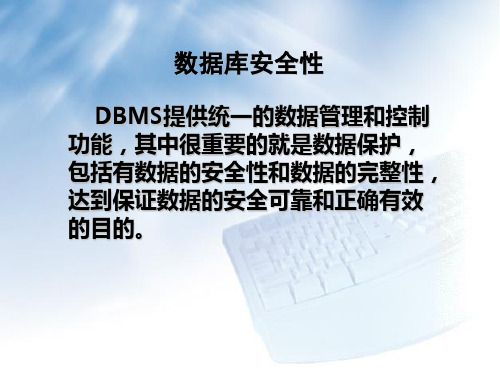
DBMS提供统一的数据管理和控制 功能,其中很重要的就是数据保护, 包括有数据的安全性和数据的完整性, 达到保证数据的安全可靠和正确有效 的目的。
4.1
计算机安全性概论
数据库的安全性和计算机系统的 安全性,包括操作系统、网络系统的 安全性是紧密联系、相互支持的。
4.1.1 计算机系统的三类安全性 问题
2. 存取控制
存取控制机制主要包括两部分: ① 定义用户权限,并将用户权限登记 到数据字典中。 在数据库系统中对存取权限的定义称 为授权(Authorization)。这些授权定 义经过编译后存放在数据字典中,被称作 “安全规则”或“授权规则”。
⑴ 用户分类 一般可对数据库的用户分为四类: 系统用户(或DBA) 数据对象的属主(Owner) 一般用户 公共用户(Public)
用户身份、身份验证和防止数据泄露及篡改
数据库内部管理:用户标识/口令、角色与权限等; 资源管理:通过系统概要文件限制连接会话等; 网络数据通信管理:采用口令文件、数据加密等高级安全 技术;
1-36
用户管理
用户类别
在数据库系统中,根据工作性质和特点,用户可分成 三类:数据库管理员(DBA)、数据库开发人员和普通用户。 不同类型的用户分别赋予不同的权限,从而保证数据 库系统的安全。
跟踪审计(Audit Trail)是一种 监视措施。数据库在运行中,DBMS跟踪 用户对一些敏感性数据的存取活动,跟 踪的结果记录在跟踪审计记录文件中 (有许多DBMS的跟踪审计记录文件与系 统的运行日志合在一起)。一旦发现有 窃取数据的企图,有的DBMS会发出警报 信息,多数DBMS虽无警报功能,也可在 事后根据记录进行分析,从中发现危及 安全的行为,找出原因,追究责任,采 取防范措施。
ORACLE-SQL语句学习教程
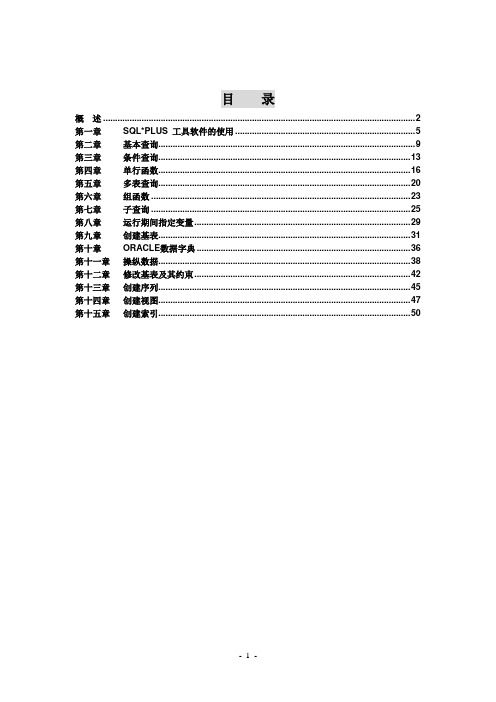
目录概述 (2)第一章SQL*PLUS 工具软件的使用 (5)第二章基本查询 (9)第三章条件查询 (13)第四章单行函数 (16)第五章多表查询 (20)第六章组函数 (23)第七章子查询 (25)第八章运行期间指定变量 (29)第九章创建基表 (31)第十章ORACLE数据字典 (36)第十一章操纵数据 (38)第十二章修改基表及其约束 (42)第十三章创建序列 (45)第十四章创建视图 (47)第十五章创建索引 (50)概述20世纪70年代初,E.F。
Codd 在计算机学会(Association of Computer Machinery,简写为ACM)期刊Communications of the ACM(ACM 通讯)发表了题为”A Relational Model of Data for Large Shared Data Banks”(大型共享数据库的数据关系模型)的论文,该论文提出的关系数据库模型成为今天最为权威的关系型数据库管理模型.IBM公司首先使用该模型开发出了结构化英语查询语言SEQUEL(Structured English Query Language),作为其关系数据库原型System R的操作语言,实现对关系数据库的信息检索.SEQUEL后来简写为SQL,即Structured Query Language(结构化查询语言)的缩写.ORACLE公司于1997年推出了第一个商业应用的SQL软件.20世纪80年代初,美国国家标准化组织(ANSI)开始着手制订SQL标准,最早的ANSI 标准于1986年颁布,它也被称为SQL-86。
标准的出台使SQL作为标准的关系数据库语言的地位得到加强。
SQL标准几经修改和完善,目前SQL语言方面新的ANSI标准是1992年制定的ANSI X3.135—1992,“Database Language SQL”。
此标准也被国际电工委员会(International Electro technical Commission,即IEC)所属的国际标准化组织(International Standards Organization, 即ISO)所接受,并将它命名为ISO/IEC9075:1992, “Database Language SQL”。
oracle进阶之model子句
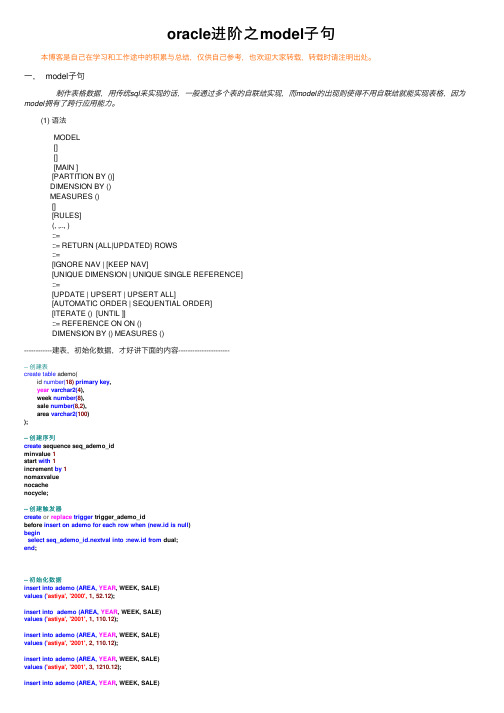
oracle进阶之model⼦句 本博客是⾃⼰在学习和⼯作途中的积累与总结,仅供⾃⼰参考,也欢迎⼤家转载,转载时请注明出处。
⼀, model⼦句 制作表格数据,⽤传统sql来实现的话,⼀般通过多个表的⾃联结实现,⽽model的出现则使得不⽤⾃联结就能实现表格,因为model拥有了跨⾏应⽤能⼒。
(1) 语法 MODEL [] [] [MAIN ] [PARTITION BY ()] DIMENSION BY () MEASURES () [] [RULES] (, ,.., ) ::= ::= RETURN {ALL|UPDATED} ROWS ::= [IGNORE NAV | [KEEP NAV] [UNIQUE DIMENSION | UNIQUE SINGLE REFERENCE] ::= [UPDATE | UPSERT | UPSERT ALL] [AUTOMATIC ORDER | SEQUENTIAL ORDER] [ITERATE () [UNTIL ]] ::= REFERENCE ON ON () DIMENSION BY () MEASURES ()------------建表,初始化数据,才好讲下⾯的内容------------------------ 创建表create table ademo(id number(18) primary key,year varchar2(4),week number(8),sale number(8,2),area varchar2(100));-- 创建序列create sequence seq_ademo_idminvalue 1start with 1increment by 1nomaxvaluenocachenocycle;-- 创建触发器create or replace trigger trigger_ademo_idbefore insert on ademo for each row when (new.id is null)beginselect seq_ademo_id.nextval into :new.id from dual;end;-- 初始化数据insert into ademo (AREA, YEAR, WEEK, SALE)values ('astiya', '2000', 1, 52.12);insert into ademo (AREA, YEAR, WEEK, SALE)values ('astiya', '2001', 1, 110.12);insert into ademo (AREA, YEAR, WEEK, SALE)values ('astiya', '2001', 2, 110.12);insert into ademo (AREA, YEAR, WEEK, SALE)values ('astiya', '2001', 3, 1210.12);insert into ademo (AREA, YEAR, WEEK, SALE)values ('astiya', '2002', 1, 170.12);insert into ademo (AREA, YEAR, WEEK, SALE)values ('astiya', '2002', 2, 680.12);insert into ademo (AREA, YEAR, WEEK, SALE)values ('astiya', '2002', 3, 680.12);insert into ademo (AREA, YEAR, WEEK, SALE)values ('anter', '2001', 1, 80.12);insert into ademo (AREA, YEAR, WEEK, SALE)values ('anter', '2001', 2, 56.72);insert into ademo (AREA, YEAR, WEEK, SALE)values ('anter', '2001', 3, 156.72);insert into ademo (AREA, YEAR, WEEK, SALE)values ('anter', '2002', 1, 640.12);insert into ademo (AREA, YEAR, WEEK, SALE)values ('anter', '2002', 2, 980.12);insert into ademo (AREA, YEAR, WEEK, SALE)values ('anter', '2002', 3, 1980.12);/*delete from ademo;*/-- 注释(这是我的个⼈习惯,不想⿇烦的可以不加)comment on table ademo is '测试经济类的表';comment on column ademo.id is '主键';comment on column ademo.year is '年份';comment on column ademo.week is 'xxx周';comment on column ademo.sale is '销售额';comment on column ademo.area is '地区';-- 展⽰数据select * from ademo;-- 例⼦1select year,week,sale,area,up_salefrom ademomodel return updated rows -- model 语句partition by (area) -- 分组dimension by (year,week) -- 维度列measures(sale,0 up_sale) -- 度量值列rules( -- 规则up_sale[year,week]=sale[cv(year),cv(week)]*10,up_sale[1999,1]=100.00 )order by year,week;-- 例⼦2select year,week,sale,area,up_salefrom ademomodelpartition by (area)dimension by (year,week)measures(sale,0 up_sale)rules(up_sale[year,week]=sale[cv(year),cv(week)]*10,up_sale[1999,for week from 1 to 3 increment 1]=100.00)order by year,week;-------------------------------------------------------------------- (2) 规则 a. 位置标记 即指定确定的位置明确的维度列值,例如:例⼦1中的规则(rules)中的up_sale[1999,1]=100.00,明确指出,year=1999,week=1的up_sale列的值为100.00, 作⽤: 位置标记通常也叫UPSERT,即update and insert,当结果集中不存在则插⼊,数量随分组的数量⽽定;存在时,则更新数据,更新的数据条数同样与分组的组数相同。
Oracle Communications Consulting (OCC)自动化测试套件版本1.0
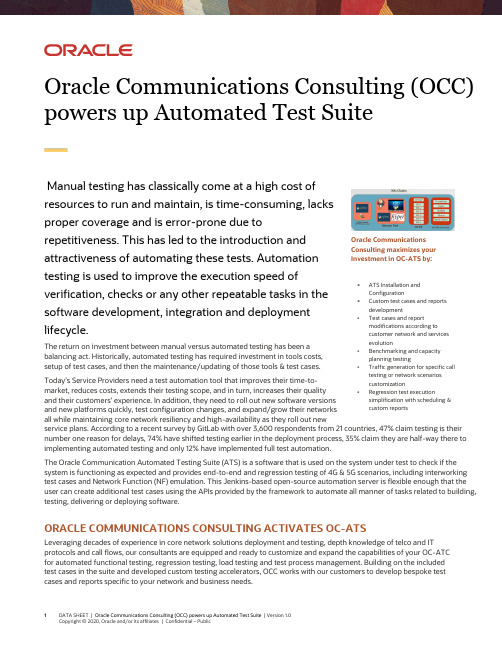
1 DATA SHEET | Oracle Communications Consulting (OCC) powers up Automated Test Suite | Version 1.0 Copyright © 2020, Oracle and/or its affiliates | Confidential – PublicOracle Communications Consulting (OCC) powers up Automated Test SuiteManual testing has classically come at a high cost of resources to run and maintain, is time-consuming, lacks proper coverage and is error-prone due to repetitiveness. This has led to the introduction and attractiveness of automating these tests. Automation testing is used to improve the execution speed of verification, checks or any other repeatable tasks in the software development, integration and deployment lifecycle.The return on investment between manual versus automated testing has been a balancing act. Historically, automated testing has required investment in tools costs, setup of test cases, and then the maintenance/updating of those tools & test cases.Today’s Service Providers need a test automation tool that improves their time-to-market, reduces costs, extends their testing scope, and in turn, increases their quality and their customers’ experience. In addition, they need to roll out new software versions and new platforms quickly, test configuration changes, and expand/grow their networks all while maintaining core network resiliency and high-availability as they roll out newservice plans. According to a recent survey by GitLab with over 3,600 respondents from 21 countries, 47% claim testing is their number one reason for delays, 74% have shifted testing earlier in the deployment process, 35% claim they are half-way there to implementing automated testing and only 12% have implemented full test automation.The Oracle Communication Automated Testing Suite (ATS) is a software that is used on the system under test to check if the system is functioning as expected and provides end-to-end and regression testing of 4G & 5G scenarios, including interworking test cases and Network Function (NF) emulation. This Jenkins-based open-source automation server is flexible enough that the user can create additional test cases using the APIs provided by the framework to automate all manner of tasks related to building, testing, delivering or deploying software.ORACLE COMMUNICATIONS CONSULTING ACTIVATES OC-ATSLeveraging decades of experience in core network solutions deployment and testing, depth knowledge of telco and ITprotocols and call flows, our consultants are equipped and ready to customize and expand the capabilities of your OC-ATC for automated functional testing, regression testing, load testing and test process management. Building on the included test cases in the suite and developed custom testing accelerators, OCC works with our customers to develop bespoke test cases and reports specific to your network and business needs.Oracle Communications Consulting maximizes your Investment in OC-ATS by:ATS Installation and ConfigurationCustom test cases and reports developmentTest cases and reportmodifications according to customer network and services evolutionBenchmarking and capacity planning testingTraffic generation for specific call testing or network scenarios customizationRegression test executionsimplification with scheduling & custom reportsCONNECT WITH USCall +1.800.ORACLE1 or visit .Outside North America, find your local office at/contact ./oracle/oracleCopyright © 2020, Oracle and/or its affiliates. All rights reserved. This document is provided for information purposes only, and the contents hereof are subject to change without notice. This document is not warranted to be error-free, nor subject to any other warranties or conditions, whether expressed orally or implied in law, including implied warranties and conditions of merchantability or fitness for a particular purpose. We specifically disclaim any liability with respect to this document, and no contractual obligations are formed either directly or indirectly by this document. This document may not be reproduced or transmitted in any form or by any means, electronic or mechanical, for any purpose, without our prior written permission.This device has not been authorized as required by the rules of the Federal Communications Commission. This device is not, and may not be, offered for sale or lease, or sold or leased, until authorization is obtained.Oracle and Java are registered trademarks of Oracle and/or its affiliates. Other names may be trademarks of their respective owners.Intel and Intel Xeon are trademarks or registered trademarks of Intel Corporation. All SPARC trademarks are used under license and are trademarks or registered trademarks of SPARC International, Inc. AMD, Opteron, the AMD logo, and the AMD Opteron logo are trademarks or registered trademarks of Advanced Micro Devices. UNIX is a registered trademark of The Open Group. 0120Disclaimer: This document is for informational purposes. It is not a commitment to deliver any material, code, or functionality, and should not be relied upon in making purchasing decisions. The development, release, timing, and pricing of any features or functionality described in this document may change and remains at the sole discretion of Oracle Corporation.CI/CD PIPELINE METHODOLOGYRecognizing that each customer’s network and needs are different, OCC designs different CD Pipelines specific to these needs. For example, in the case of a new software release, ATS use case tests are deployed automatically against the new software.ORACLE COMMUNICATIONS CONSULTING EXTENDS THE FUNCTIONALITY AND CAPABILITIES OF YOUR OC-ATSAs your network traffic evolves, so must your OC-ATS test cases and reports. It isimportant that OC-ATS undergoes regular test cases reviews and that adjustments are made or new use cases tests are developed. In today’s virtualized and cloud native environments, where 4G/5G applications are no longer deployed onproprietary hardware, changes in underlying environments can happen, and often outside the control of Service Providers. It is of critical importance that regression testing is powerful, is customized to your needs and delivers meaningful reports and data. The ability to quickly deploy these new test cases is especially critical for interworking and policy rule case additions which can be done expeditiously, run daily and include subscriber/subscription lifecycle.These OC-ATS extensions include, but are not limited to: end-to-end use cases, customer ad-hoc use cases, enhanced use case validation, a test scheduler and reports, and a test creation user interface. In addition, OCC can enhance OC-ATS with additional capabilities, such as network topology, NF simulators, chaos testing, hybrid/public cloud hosting and integration with customer toolchain.TRUST THE EXPERTSOCC possess both the intimate knowledge of the elements under test in your 4G/5G network and the ATS framework to quickly design and develop the test cases and reports your company needs to continually check and ensure your solution is running smoothly and optimally with the minimum use of your resources. In today’s Cloud environ ments, it is necessary to continually check the integrity and health of the entire end-to-end solution and alert to any issues network or elemental changes have introduced. This is only possible with continual automated testing which has been powered by Oracle Communications Consulting.Oracle Communications Consulting extends your OC-ATS with:Evolution and Maintenance Ad-hoc Test CasesPowerful Regression Testing Extended CapabilitiesOut-of-the-box Standalone NF Test Cases Modifications Test Scheduler Custom ReportsChaos Testing。
ORACLE公司简介2

二、应对策略
在制定反击策略时,甲骨文以所谓“开心乐园餐” 作为反击。过去甲骨文的数据库只是一个平台,
平台上的应用多由其他公司开发,但自2000年底 起,该公司自行推出一套叫“电子商务套餐”(ebusiness suite)的软件,内有人事管理系统、销 售系统,全都是植根在数据库上的程式。
三、收购sun公司后的明确定位
公司简介
一、Oracle公司(甲骨文公司)是世界领先的信息管理软件 供应商和世界第二大独立软件公司。向遍及145多个国家的 用户提供数据库、工具和应用软件以及相关的咨询、培训 和支持服务。 二、Oracle是第一个跨整个产品线(数据库、业务应用软件 和应用软件开发与决策支持工具)开发和部署100%基于互 联网的企业软件的公司。Oracle公司拥有世界上唯一一个 全面集成的电子商务套件Oracle Applications R11i,它能够 自动化企业经营管理过程中的各个方面,深受用户的青睐 , Oracle电子商务解决方案的核心优势就在于它的集成性和 完整性 。甲骨文的核心经营理念是:战争营销,抢占市场。 三、Oracle应用产品包括财务、供应链、制造、项目管理、 人力资源和市场与销售等150多个模块,荣获多项世界大奖, 现已被全球近7600多家企业所采用。
期间为避免有个别地区不从,甲骨文更改赏罚机制。过去
地区经理以营业额作评分,现在以边际利润(profit margin)比高下。要是拒绝采用中央的系统,地区要自行 付钱。基本改革初尝甜头,甲骨文再把销售、财务等系统 整合,年省6,000多万美元维修费。
最后Oracle认为系统可以改,企业架构也应该改。艾利森
1989年Oracle公司正式进入中国市场,成为第一家进
入中国的世界软件巨头,标志着刚刚起飞的中国国民 经济信息化建设已经得到Oracle的积极响应,由 Oracle首创的关系型数据库技术开始服务于中国用户 。1991年7月,经过了近两年时间的努力开拓,为了更 好地与迅速发展的业务相适应,Oracle在北京建立独 资公司。今天的Oracle中国公司拥有超过3500名员工 ,并在全国十二个城市设立了分公司。
Oracle 企业级数据中心解决方案
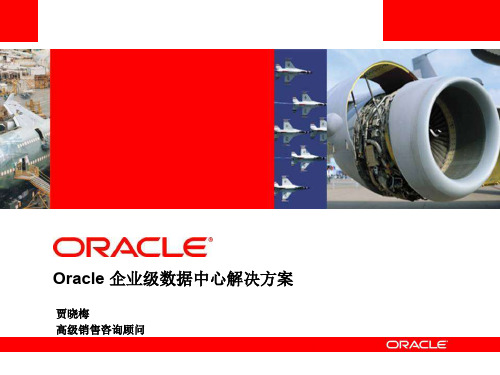
Data Profiling
Oracle EPM/BI
Data Replication BI Server Foundation
Storage
Data Warehouse/ Data Mart
OLTP System
OLAP Cube
Files and Web 2.0 Content Management
辅助决策
通过统一的数据中心系统为企业领导实现 规范、准确、及时的企业经营分析提供基 础。
议程
• • • • 企业信息化建设面临的挑战 数据中心解决方案 Oracle技术支撑平台 Q&A
数据中心的技术实现层面
搭建统一的数据集成与共享平台:实现信息 的共享和应用。
搭建统一的主数据管理平台:提高数据质量 ,消除数据冗余,实现唯一真实可信的数据( single truth view)。
可靠性
保证交易的一致性 – 稳定、可靠、具备各种故障 下的恢复能力
23
23
GoldenGate 工作原理
Capture: 实时读取交易日志捕捉数据变化并可实现过滤. 队列文件: 暂存数据变化. 传输: 数据经过压缩和加密传送到目的地. Delivery:执行所需的数据变化,然后将 数据变化提交到目的库.
主数据管理
商业智能
面对信息孤岛的解决之道-整合
DW/BI
MDM
SOA
面对孤岛的解决之道-整合
数据中心的目的
规范、整合、共享、支撑
规范数据
保证不同业务系统数据相对独立的基础上,建立数据交换和共 享机制,通过对数据的加工、清洗、传递和交换,实现数据的 标准化、一致化。
信息HUB
建立信息生命周期中各种分散资源的管理 与协调中心,使分布在不同地域、部门的 生产、财务、销售等人员都可以从这个中 心出发开展工作。
oracle sql developer data modeler使用
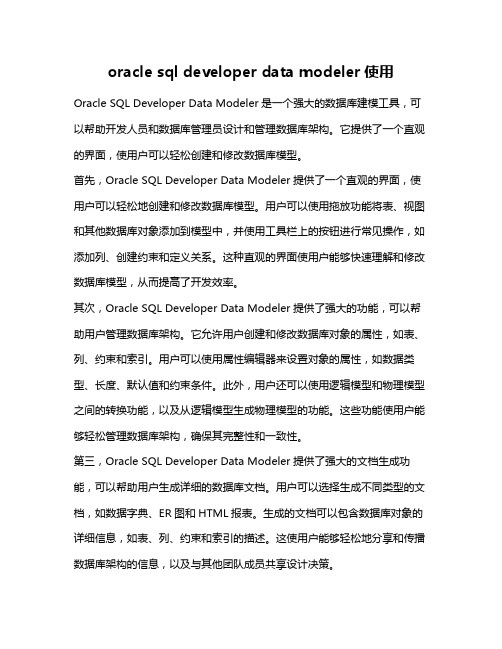
oracle sql developer data modeler使用Oracle SQL Developer Data Modeler是一个强大的数据库建模工具,可以帮助开发人员和数据库管理员设计和管理数据库架构。
它提供了一个直观的界面,使用户可以轻松创建和修改数据库模型。
首先,Oracle SQL Developer Data Modeler提供了一个直观的界面,使用户可以轻松地创建和修改数据库模型。
用户可以使用拖放功能将表、视图和其他数据库对象添加到模型中,并使用工具栏上的按钮进行常见操作,如添加列、创建约束和定义关系。
这种直观的界面使用户能够快速理解和修改数据库模型,从而提高了开发效率。
其次,Oracle SQL Developer Data Modeler提供了强大的功能,可以帮助用户管理数据库架构。
它允许用户创建和修改数据库对象的属性,如表、列、约束和索引。
用户可以使用属性编辑器来设置对象的属性,如数据类型、长度、默认值和约束条件。
此外,用户还可以使用逻辑模型和物理模型之间的转换功能,以及从逻辑模型生成物理模型的功能。
这些功能使用户能够轻松管理数据库架构,确保其完整性和一致性。
第三,Oracle SQL Developer Data Modeler提供了强大的文档生成功能,可以帮助用户生成详细的数据库文档。
用户可以选择生成不同类型的文档,如数据字典、ER图和HTML报表。
生成的文档可以包含数据库对象的详细信息,如表、列、约束和索引的描述。
这使用户能够轻松地分享和传播数据库架构的信息,以及与其他团队成员共享设计决策。
最后,Oracle SQL Developer Data Modeler还提供了与Oracle数据库的无缝集成。
用户可以直接从工具中连接到Oracle数据库,并执行SQL脚本和查询。
此外,它还提供了与其他数据库管理系统(如MySQL和Microsoft SQL Server)的集成,使用户能够在不同的数据库平台上使用相同的工具和功能。
Oracle Communications Acme Packet 6300 Series 数据表说

Acme Packet 6300 Series combines groundbreaking performance,capacity, and system throughput with the most proven and comprehensive session delivery functions and features in the industry. Featuring the 3RU Acme Packet 6300 (see Figure 1) and Acme Packet 6350 Dual NIU and Acme Packet 6350 Quad NIU (see Figure 2), the 6300 Series is building the foundation for future generation Internet Protocol (IP) real-time communications (RTC) services.OVERVIEWAcme Packet 6300 Series is based on a next-generation hardware design that leverages state-of-the-art components and 64-bit symmetrical multiprocessing (SMP) in a modular system designed for growth and flexibility. It operates the same version of Acme Packet OS as all other Acme Packet platforms for ease of management and uncompromised field-proven functionality in many product configurations and options. The 6300 Series provides for flexible deployment at high-volume network access or interconnect borders or within the service provider signaling core.Figure 1: Acme Packet 6300Figure 2: Acme Packet 6350Breakthrough performance in a field- proven designAPPLICATIONS• Service provider SBC for access and interconnect applications• High -performance SIP session routing• Combination access SBC with IMS core and session management functionsKEY FEATURES• High -performance, purpose-built multiprocessor design• Acme Packet 6300, 6350 Dual NIU and 6350 Quad NIU feature three slots for modular flexibility • Market -leading Acme Packet OS functions, features and configurations• 40 Gb/sec (6300, 6350 Dual NIU and 6350 Quad NIU) system throughput• Leverages proven SBC design with state-of-the-art componentsKEY BENEFITS• Capable of supporting up to 3,000,000 simultaneous subscribers• Protects investment in existing SBC infrastructure• Meets all emerging service requirements in efficient 3RU (6300, 6350 Dual NIU and 6350 Quad NIU) form factor• Reduced total cost of ownershipBased on a common architecture that tightly integrates Acme Packet OS with Oracle’s distributed multiprocessor hardware, each platform in the 6300 Series can handle the signaling and media traffic generated by next-generation services such as voice over Long Term Evolution (VoLTE); rich communication services (RCS) and enhanced RCS (RCS-e), and high-definition video calling. It features Oracle’s car rier-class high availability (HA) and Network Equipment Building Systems (NEBS) certification to ensure nonstop operation and survivability in the most business-critical services and applications.ACME PACKET 6300 SERIES FLEXIBILITY, SCALE AND EFFICIENCYAcme Packet 6300 Series systems leverage common state-of-the-art components, design and system architecture. The 6300, 6350 Dual NIU and 6350 Quad NIU deliver up to 40 Gb/sec of system throughput.ACME PACKET 6300 SERIES PLATFORM FEATURES, CAPACITY, AND PERFORMANCEa. Actual number will vary based on features enabled and call mode.b. Configuration dependent, based on 180 sec ACHT.c. Based on 20ms delay and G.711 and G.729 codecs.Note: Performance and capacity based on Oracle Communications Session Border Controller v8.0 softwareACME PACKET 6300 SERIES SUPPORTED CONFIGURATIONSThe Acme Packet 6300 Series operates Acme Packet OS in a variety of high-end product configurations designed for a wide array of services and applications.NETWORK SESSION DELIVERY AND CONTROL INFRASTRUCTURE PRODUCTS AND CONFIGURATIONS SUPPORTED BY ACME PACKET 6300 SERIESNote: Some product / configurations are not supported on all 6300 series members NETWORK SESSION DELIVERY AND CONTROL INFRASTRUCTUREOracle’s network session delivery and control infrastructure enables enterprises and service providers to manage the many challenges in the delivery of IP voice, video, and data services and applications. Service provider solutions are deployed at network borders and in the IP service core to help fixed-line, mobile, wholesale, and over-the-top service providers optimize revenues and realize long-term cost savings. In the enterprise, session delivery infrastructure solutions seamlessly connect fixed and mobile users, enabling rich multimedia interactions and automating business processes for significant increases in productivity and efficiency.The following Oracle products are part of the network session delivery and control infrastructure:∙Oracle CommunicationsSession Border Controller∙Oracle CommunicationsSession Router∙Oracle CommunicationsSubscriber-Aware LoadBalancer∙Oracle Communications Unified Session Manager∙Oracle Communications Mobile Security Gateway∙Oracle CommunicationsInteractive Session Recorder∙Oracle Communications Core Session Manager∙Oracle Enterprise SessionBorder Controller∙Oracle CommunicationsSession Delivery ManagementSuite∙Acme Packet 1100∙Acme Packet 3900∙Acme Packet 4600∙Acme Packet 6300∙Acme Packet 6350 Dual NIU∙Acme Packet 6350 Quad NIUHARDWAREThe Acme Packet 6300 Series feature Oracle’s integrated multiprocessor design to achieve the industry’s highest system-level performance and capacity for signaling, media, and encryption. Acme Packet 6300, 6350 Dual NIU and 6350 Quad NIU also feature industry-leading transcoding capacity and features. Powerful network processor drive system throughput up to 40 Gb/sec (6300, 6350 Dual NIU and 3650 Quad NIU) in fully-populated systems. The versatility, carrier-grade hardware design, and high-availability makes the 6300 Series suitable for deployment at large service provider access and interconnect network borders or within the IP Multimedia Subsystem (IMS) signaling core.The front of Acme Packet 6300 Series platforms features a bright vacuum fluorescent display (VFD) with a front panel keypad and individual fan assemblies to deliver precise and consistent airflow for optimal cooling of all processors and internal components. Each fan assembly can be replaced individually while the system is in service. A black front bezel hides the fan assemblies without restricting airflow through the system. Acme Packet 6300, 6350 Dual NIU and 6350 Quad NIU feature fifteen individual fan assemblies, five for each of its three slots.The rear of Acme Packet 6300, 6350 Dual NIU and 6350 Quad NIU include three slots for NIUs or TCUs with at least one slot reserved for an NIU. One or two slots can be populated with TCUs. The rear of the chassis also accommodates fully redundant power supplies, console and alarm ports, and management ports. A separate rear slot accommodates a 480 GB solid state drive. The power supplies and drives are hot replaceable. Light-emitting diode (LED) indicators for all field-replaceable modules (FRUs) provide at-a-glance power and redundancy status.Acme Packet 6300 Series platforms support two-stage hardware-accelerated encryption to assure confidentiality, privacy and integrity for IP real-time communications at wire rate. 6300 Series Secure Services Module 3 (SSM3) performs compute-intensive random number generation, TLS encryption and IKE key generation to accelerate call setup for encrypted SIP sessions. Encryption co-processors on 6300 Series NIUs support standard IPsec and SRTP for encrypting RTP media.Acme Packet 6300 Rear Slot ModulesOne of the three Acme Packet 6300, 6350 Dual NIU and 6350 Quad NIU rear slots (slot 0) is populated with a NIU; the other two slots can accommodate either NIUs or TCUs. NIU options deliver hardware-accelerated advanced media controls, such as quality of service (QoS) monitoring and encryption and denial of service (DoS) attack protection far beyond the capabilities of general purpose server-based platforms.Dual Port 10 Gigabits per Second Network Interface UnitThe 2x10 Gb/sec NIU is an ultrahigh-performance NIU that integrates dual 32-core processors with options for high-performance, high-capacity encryption for line-rate security even at maximum system throughput. This ensures uncompromised end user or subscriber quality of experience. NIU processors also integrate QoS monitoring and measurement in addition to intelligence designed to protect the rest of the system in the event of signaling overloads or fuzzing attacks. The 10 Gb/sec NIU also supports hardware acceleration of SIP sessions encrypted with TLS, Datagram Transport Layer Security (DTLS), or Internet Key Exchange (IKE) for privacy and confidentiality.High Capacity Transcoding Carrier Unit (Acme Packet 6300, 6350 Dual NIU and Quad NIU)The Acme Packet 6300, 6350 Dual NIU and Quad NIU Transcoding Carrier Unit (TCU) delivers high- performance, high capacity hardware-accelerated transcoding and transrating for services and applications requiring the highest levels of scale and codec management. Each TCU leverages up to 24 transcoding modules, to support up to 30,000 transcoded sessions for a total of up to 60,000 transcoded sessions when Acme Packet 6300 and 6350 are populated with dual TCUs. The AcmePacket 6300, 6350 Dual NIU and Quad NIU transcoding hardware complements the extensive codec management functionality supported by the Oracle Communications Session Border Controller (SBC).ACME PACKET 6300 SERIES DETAILSDetails of Acme Packet 6300 Series specifications, power, physical properties, and regulatory compliance are listed in the table below.DETAILS OF ACME PACKET 6300 SERIESCONNECT WITH USCall +1.800.ORACLE1 or visit .Outside North America, find your local office at /contact./oracle /oracle /oracleCopyright © 2019, Oracle and/or its affiliates. All rights reserved. This document is provided for information purposes only, and the contents hereof are subject to change without notice. This document is not warranted to be error-free, nor subject to any other warranties or conditions, whether expressed orally or implied in law, including implied warranties and conditions of merchantability or fitness for a particular purpose. We specifically disclaim any liability with respect to this document, and no contractual obligations are formed either directly or indirectly by this document. This document may not be reproduced or transmitted in any form or by any means, electronic or mechanical, for any purpose, without our prior written permission.Oracle and Java are registered trademarks of Oracle and/or its affiliates. Other names may be trademarks of their respective owners.Intel and Intel Xeon are trademarks or registered trademarks of Intel Corporation. All SPARC trademarks are used under license and are trademarks or registered trademarks of SPARC International, Inc. AMD, Opteron, the AMD logo, and the AMD Opteron logo are trademarks or registered trademarks of Advanced Micro Devices. UNIX is a registered trademark of The Open Group. 1119。
Oracle的model用法简介

Oracle的model用法简介2010-04-22 10:15Model语句是Oracle 10g的新功能之一。
本文通过一些简单的例子帮助理解Model语句的用法,复杂使用场景请参考其他文章。
环境:当然需要Oracle 10g以上,本人是在11g上测试的。
1. 什么是model语句model语句是Oracle10g的新功能,可以在select语句里面像其他编程语言操作数组一样,对SQL的结果集进行处理。
执行顺序是位于Having之后。
select的解析执行顺序1. from语句2. where语句 (结合条件)3. start with语句4. connect by语句5. where语句6. group by语句7. having语句8. model语句9. select语句10. union、minus、intersect等集合演算演算11. order by语句model的好处Oracle 9i为止,需要使用各种计算分析函数,union all等,以及借助其他开发语言(C#及Java等)进行复杂计算统计合并等。
使用Model之后,这些都可以在SQL里面进行了。
model典型使用场景。
1.合计行追加2.行列变换3.使用当前行的前后行4.RegExp_Replace函数的循环执行2. HelloWorld先看一个简单的例子。
例句1select ArrValue,soejifrom (select 'abcdefghijklmn' as ArrValue,1 as soeji from dual)modeldimension by(soeji)measures(ArrValue)rules(ArrValue[1] = 'Hello World');结果:ArrValue soejiHello World 1说明:model model语句的关键字,必须。
dimension by dimension维度的意思,可以理解为数组的索引,必须。
《Oracle模块介绍》
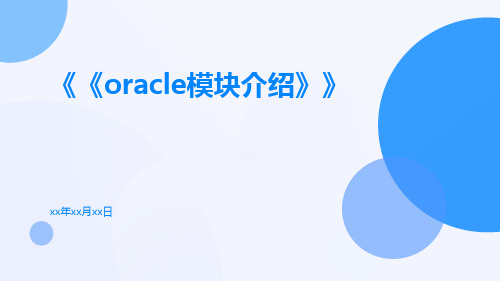
监听器是Oracle实例与客户端应用程序之间的接口,您需要配置监听器以方便客户端连接。
Oracle实例的创建和删除
要点一
创建实例
要点二
删除实例
使用DBCA(数据库配置助手)或其 他工具创建新的Oracle实例。
在不再需要使用时,可以使用DBCA 或手动删除Oracle实例。
要点三
实例备份与恢复
Oracle应用模块
Oracle财务系统
财务管理
包括总账、明细账、报表等模块,可 以帮助企业实现财务管理规范化、高 效化。
成本控制
通过预算编制、成本核算、费用控制 等功能,帮助企业控制成本,提高盈 利能力。
财务分析
提供多种财务分析方法,帮助企业进 行财务状况评估、预测和决策。
Oracle人力资源管理系统
安装程序
从Oracle官方网站下载并安装适 用于您的操作系统的Oracle软件 包。
安装选项
在安装过程中,您可以选择创建 桌面图标、启动环境变量设置等 个性化选项。
Oracle数据库的配置
数据库实例
在Oracle中,一个数据库实例是由一组后台进程和相关内存结构组成的。
数据库服务
数据库服务是Oracle软件包的核心,它负责数据的存储、检索和管理。
介绍Oracle并行查询的原理、 实现方式和性能优化方法,以及 与其他数据库系统的比较。
介绍并行DML操作的原理、实 现方式和性能优化方法,以及与 其他数据库系统的比较。
Oracle分布式数据库系统
分布式数据库概述
01
介绍分布式数据库的基本概念、优点和适用场景,以及Oracle
分布式数据库的发展历程和现状。
一种Oracle特有的编程语言,用于开发数据库存储过程、触发器和函数等数据库 对象,也用于封装复杂的业务逻辑和数据处理流程。
Oracle Communications Solution Integrations RODOD

Oracle Communications Solution IntegrationsUnderstanding the RODOD Reference SolutionProduct ManagementMarch 2015Safe Harbor StatementThe following is intended to outline our general product direction. It is intended for information purposes only, and may not be incorporated into any contract. It is not a commitment to deliver any material, code, or functionality, and should not be relied upon in making purchasing decisions. The development, release, and timing of any features or functionality described for Oracle’s products remains at the sole discretion of Oracle.Generally Available ApplicationsInstallationScripts &ConfigurationReferenceExamples& BestPracticesRODODReferenceSolutionWhat is the RODOD Reference Solution?•NEW with RODOD & AIA Comms 11.4 •Unattended installation of RODOD reduces skillsets and timelines for a standard install•Reference Data illustrates configuration best practices •Try out new & existing RODOD features•Common API extensions provided as samples •Low Risk standard RODOD Configuration •Self-contained RODOD install* for wider access •Suitable for training, demos, pre-sales, requirements definition, evaluation•Suitable for developing integrations, extensions to 3rd party systems, development systems, adapt & extend•NEW Available via OTN•Used by Development internally. Previously available only through Oracle Communications Consulting. •Free for use with commercial license applications including demo & partner licenses•OTN content is free but provided as-is. Partners & End-users are responsible for support •Requirements to Use References •Understanding of RODOD & Oracle application install •Read & review our Reference Documentation to ensure application compatibility•Acquire commercial applications via paid license or partner and/or demonstration licenses •Understanding of Linux OS, scripting, file systems, permissionsSharing RODOD Best Practices with RODOD ReferencesTrained on RODOD References using Guided Learning Paths Deployed in Partner Labs Forms the basis of Solution Driven Design and the Standard Solution for BSS & OSS.Over 2 years using our tools & references on key projects.Courseware & Transfer of Information (TOI) built on top of RODOD References Best Practices & Guidelines built from real customer deployments.Who is using RODOD References?Available through Oracle Technology Network•Well established fordistributing Oracleproduct samples•Use MIT License Termsfor Reference content•Organized collateralaround our BSS & OSSsolutions and clear linksto products•Available to both end-customers and SIpartnersRODOD Reference Solution: Unattended Installation•RODOD “typical” topology •Single instance of each application,•Minimum 4 x 16GB VMs with OEL/RHEL•Optional AMP/OEM for discovery & monitoring •Optional Revenue Management Suite IP 1.1•OEL 6.5+ / RHEL•DB 11g per each application, optional DB RAC •OSM O2A deployed with Calculate Service Order (CSO)•WLS Domains for each of AIA, OSM, PDC, AMP•Optional WLS Clustering for AIA & OSM This installation is not secure by default. It is intended for demonstration, training, enablement on RODOD. Please consult the secure installation guide for each application when deploying with live customer data or on a live network.Media Server Execute Unattended Install Siebel CRM RMS (BRM & PDC) AIA 11.4 PIPsOSM with O2A Windows / Browsers Design StudioAMP/OEMRODOD Reference Solution Compatibility MatrixApplication Version SummarySiebel for Communications 8.1.1.14 / IP14 Open UI, Bulk opsBilling & Revenue Management 7.5 PS10 ECE, install with (optional) RMS Reference Solution Product Design Center 11.1.0.6AIA for Communications 11.4 11g-based Technology stack (certified)AIA for Communications Product Integration Packs 11.4 Corporate Accounts, Legal Entity Collections, Payment onOrder, New attributes on EBO for SOMOrder & Service Management 7.2.4.1 Large orders, OTMOrder & Service Management Cartridges for Order-to-Active (O2A) 2.1.0 Includes OTM and provides a Calculate Service Order(CSO) functionality. New sample SOMThe RODOD Reference Solution installs the latest certified applications based on AIA for Communications 11.4. The installation scripts are not certified for all combinations and do not provide upgrade(s).RODOD Reference Solution: New AIA 11.4 & AMP Features •Siebel Open UI with bulk order handling•Corporate Account Hierarchy•Legal Entities & Split Billing•Family Share Plans•Electronic Bill Presentment (EBP)•A charging use-case to illustrate RODOD-RMS integration •Discover RODOD stack from OEM Application Management Packs (AMP)•Offer design with PDC, BRM & Siebel•Plus core and legacy RODOD features for Order Capture, Order Delivery & Agent Assisted Billing & CareMost new features will include public recordings. The recordings are built based on the RODOD Reference Solution and can be followed step-for-step on the Reference Installation•Go to the OTN site for RODOD•Start with a review of our RODODcollateral before Reference installation •Download the install scripts & document packages •Review the installation presentation, Getting Started & install recordings •Install RODOD •Try-out RODOD features based on the User Guide and recordingsRODOD Reference Solution: Next StepsRODOD Reference What’s New RODOD Reference Installation Getting Started Guide TOI Install Recordings on Oracle UniversityInstallation GuideRODOD Reference Data & Use Cases RODOD Reference User GuideTOI User Demo Recordings on OUSafe Harbor StatementThe preceding is intended to outline our general product direction. It is intended for information purposes only, and may not be incorporated into any contract. It is not a commitment to deliver any material, code, or functionality, and should not be relied upon in making purchasing decisions. The development, release, and timing of any features or functionality described for Oracle’s products remains at the sole discretion of Oracle.。
Oracle数据库运维案例介绍
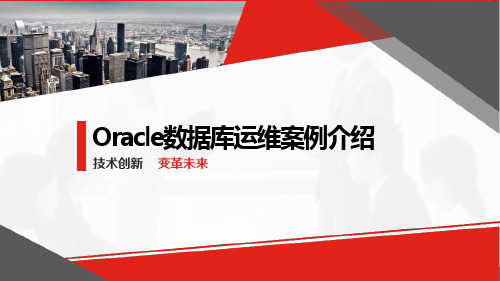
14:29
.......
1 gc buffer busy acquire 278 20170805 14:57 1 gc buffer
busy release 300 20170805 14:57 1 gc cr block lost 6
20170805 14:57 1 gc buffer busy acquire 184 20170805
Oracle数据库运维案例介绍
技术创新 变革未来
Sat Oct 08 16:14:10 2016 IPC Send timeout detected. Sender: ospid 11292 [oracle@xxxx (LMS3)] Receiver: inst 1 binc 429417348 ospid 11405 …… IPC Send timeout detected. Sender: ospid 11278 [oracle@xxxx (LMD0)] Receiver: inst 1 binc 429417294 ospid 11388 IPC Send timeout to 1.0 inc 10 for msg type 65518 from opid 12 Sat Oct 08 16:14:51 2016 IPC Send timeout detected. Sender: ospid 11270 [oracle@xxxx (PING)] Receiver: inst 1 binc 429417288 ospid 11376 Sat Oct 08 16:14:59 2016 Detected an inconsistent instance membership by instance 2 Evicting instance 1 from cluster
oracle contact导出数据非科学计数法
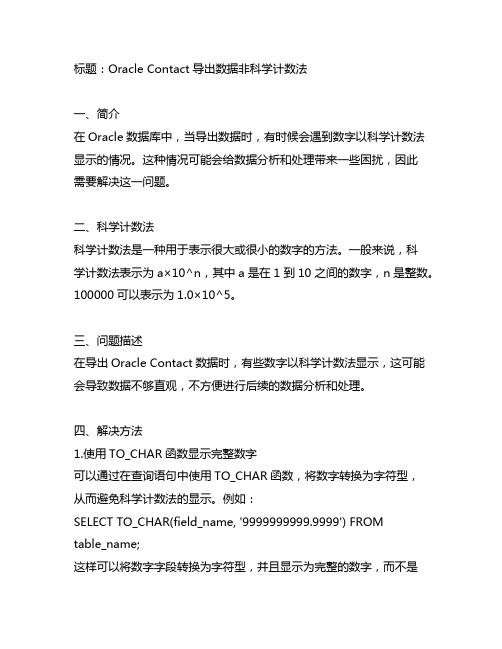
标题:Oracle Contact导出数据非科学计数法一、简介在Oracle数据库中,当导出数据时,有时候会遇到数字以科学计数法显示的情况。
这种情况可能会给数据分析和处理带来一些困扰,因此需要解决这一问题。
二、科学计数法科学计数法是一种用于表示很大或很小的数字的方法。
一般来说,科学计数法表示为a×10^n,其中a是在1到10之间的数字,n是整数。
100000可以表示为1.0×10^5。
三、问题描述在导出Oracle Contact数据时,有些数字以科学计数法显示,这可能会导致数据不够直观,不方便进行后续的数据分析和处理。
四、解决方法1.使用TO_CHAR函数显示完整数字可以通过在查询语句中使用TO_CHAR函数,将数字转换为字符型,从而避免科学计数法的显示。
例如:SELECT TO_CHAR(field_name, '9999999999.9999') FROMtable_name;这样可以将数字字段转换为字符型,并且显示为完整的数字,而不是科学计数法。
2.修改Oracle客户端工具设置有些Oracle客户端工具在导出数据时可以设置显示格式,可以尝试修改这些设置。
SQL Developer可以在Preferences -> Database -> NLS中修改"Number Format"。
3.使用Excel等工具处理导出数据即使数据在导出时是以科学计数法显示的,可以通过将数据导入Excel 等工具,再进行格式设置,将科学计数法转换为一般数字显示。
Excel 会根据字段的数据类型自动进行一些格式转换,可以在格式设置中进行更详细的修改。
五、总结在Oracle数据库中,导出数据非科学计数法可能会对数据的分析和处理带来困扰,但可以通过一些方法来解决这一问题。
可以在查询语句中使用TO_CHAR函数将数字转换为字符型,可以尝试修改Oracle客户端工具的显示格式设置,也可以在导出数据后使用Excel等工具进行格式转换。
Oracle Communications Google Voice 集成说明书
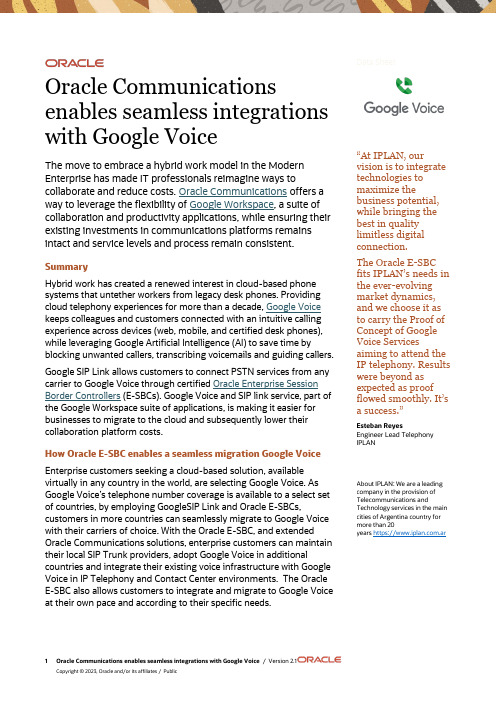
Data Sheet Oracle Communicationsenables seamless integrationswith Google VoiceThe move to embrace a hybrid work model in the Modern Enterprise has made IT professionals reimagine ways to collaborate and reduce costs. Oracle Communications offers away to leverage the flexibility of Google Workspace, a suite of collaboration and productivity applications, while ensuring their existing investments in communications platforms remains intact and service levels and process remain consistent. SummaryHybrid work has created a renewed interest in cloud-based phone systems that untether workers from legacy desk phones. Providing cloud telephony experiences for more than a decade, Google Voice keeps colleagues and customers connected with an intuitive calling experience across devices (web, mobile, and certified desk phones), while leveraging Google Artificial Intelligence (AI) to save time by blocking unwanted callers, transcribing voicemails and guiding callers. Google SIP Link allows customers to connect PSTN services from any carrier to Google Voice through certified Oracle Enterprise Session Border Controllers (E-SBCs). Google Voice and SIP link service, part of the Google Workspace suite of applications, is making it easier for businesses to migrate to the cloud and subsequently lower their collaboration platform costs.How Oracle E-SBC enables a seamless migration Google Voice Enterprise customers seeking a cloud-based solution, available virtually in any country in the world, are selecting Google Voice. As Google Voice’s telephone number coverag e is available to a select set of countries, by employing GoogleSIP Link and Oracle E-SBCs, customers in more countries can seamlessly migrate to Google Voice with their carriers of choice. With the Oracle E-SBC, and extended Oracle Communications solutions, enterprise customers can maintain their local SIP Trunk providers, adopt Google Voice in additional countries and integrate their existing voice infrastructure with Google Voice in IP Telephony and Contact Center environments. The Oracle E-SBC also allows customers to integrate and migrate to Google Voice at their own pace and according to their specific needs.“At IPLAN, our vision is to integrate technologies to maximize the business potential, while bringing the best in quality limitless digital connection.The Oracle E-SBC fits IPLAN’s needs in the ever-evolving market dynamics, and we choose it as to carry the Proof of Concept of Google Voice Services aiming to attend the IP telephony. Results were beyond as expected as proof flowed smoo thly. It’s a success.”Esteban ReyesEngineer Lead Telephony IPLANAbout IPLAN: We are a leading company in the provision of Telecommunications and Technology services in the main cities of Argentina country for more than 20years https://.arAdvantagesCloud– For customers choosing the cloud-based Google Voice and SIP Link service, the Oracle E-SBC can be deployed anywhere. Where necessary for regulatory or compliance reasons, the Oracle E-SBC can also be deployed either as a physical device or as a Virtual Network Function (VNF). Cloud deployments are available on the majority of public clouds, including Oracle Cloud Infrastructure. Vendor independent– Oracle has more than 20 years of heritage connecting and protecting enterprise networks with a security-first mindset and a future-proof road map. Our interoperability is proven in matching communication systems, cloud providers and PSTN requirements.Security– Connecting to cloud communication solutions requires adequate levels of security. Specialized in protecting real time communications to prevent bad actors entering the network, Oracle offers solutions to connect securely to cloud communication solutions, includingJITC/FIPS 140-2 military grade certifications.tekVizion Labs TM“Configuration Guide for Google Voice SIP Link Using the Oracle E-SBC” is available here.Complementing Oracle solutionsOracle offers a complete suite of enterprise communications solutions enabling enterprises in their move to the cloud to help cut IT costs, streamline processes, and boost performance whilekeeping networks reliable and protected against cyberattacks.Enterprise Operations Monitor (EOM) - To complement interoperability and security provided by the Oracle E-SBC, Oracle’s Enterprise Operations Monitor can provide real-time, end-to-end visibility for all encrypted communications running between Oracle Communications E-SBC and GoogleVoice.Enterprise Communications Broker (ECB)- For the most complex environments,Oracle’s Enterprise Communications Broker complements the Oracle E-SBC by providing a central location where customers can aggregate complex routing policies and enable flexible dial plan interworkingmanagement. The Oracle ECB can also streamline migration to Unified Communications as a Service (UCaaS) and Contact Center as a Service (CCaaS) environments as well as playing a key role in hybrid environments in which the on-premises telephony infrastructure co-exists with new Cloud Communications platforms.Oracle Communications Security Shield Cloud (OCSS) - Cyberthreats are rising and becoming more sophisticated, so securing only the infrastructure is no longer a sufficient approach. Oracle Communications Security Shield Cloud is a SaaS solution that automatically identifies telephony threats before they reach the telephony infrastructure, being on premises or cloud based.Oracle and Google SIP Link enable integrated communications and cloud solutionsThe combination of Google SIP Link and Oracle allows customers to:●Reduce the total cost of ownership of their UC platform●Improve the user experience of their collaboration platform and accelerate the adoption ofvoice as a collaboration tool●Migrate to cloud communications at their own pace●Implement maximum flexibility with advanced network-wide licensing models●Protect the communication network and optimize efficiency●Connect analog phones, door phones, fax machines and ISDN connections●Manage disruptions and service interruptions by deploying High-Available and connected E-SBCsOracle Communications provides solutions to accelerate digital transformation in acommunications-driven world from network evolution to digital business to customer experience.Connect with usCall +1.800.ORACLE1 or visit . Outside North America, find your local office at: /contact. /oracle /oracleCopyright © 2023, Oracle and/or its affiliates. All rights reserved. This document is provided for information purposes only, and the contents hereof are subject to change without notice. This document is not warranted to be error-free, nor subject to any other warranties or conditions, whether expressed orally or implied in law, including implied warranties and conditions of merchantability or fitness for a particular purpose. We specifically disclaim any liability with respect to this document, and no contractual obligations are formed either directly or indirectly by this document. This document may not be reproduced or transmitted in any form or by any means, electronic or mechanical, for any purpose, without our prior written permission. This device has not been authorized as required by the rules of the Federal Communications Commission. This device is not, and may not be, offered for sale or lease, or sold or leased, until authorization is obtained. Oracle and Java are registered trademarks of Oracle and/or its affiliates. Other names may be trademarks of their respective owners. Intel and Intel Xeon are trademarks or registered trademarks of Intel Corporation. All SPARC trademarks are used under license and are trademarks or registered trademarks of SPARC International, Inc. AMD, Opteron, the AMD logo, and the AMD Opteron logo are trademarks or registered trademarks of Advanced Micro Devices. UNIX is a registered trademark of The Open Group. 0120。
Oracle Documaker 12.5发布说明书
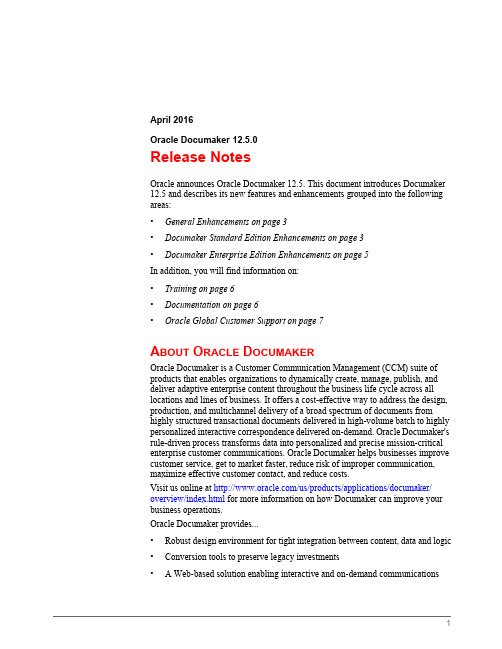
April 2016Oracle Documaker 12.5.0Release NotesOracle announces Oracle Documaker 12.5. This document introduces Documaker 12.5 and describes its new features and enhancements grouped into the following areas:•General Enhancements on page 3•Documaker Standard Edition Enhancements on page 3•Documaker Enterprise Edition Enhancements on page 5In addition, you will find information on:•Training on page 6•Documentation on page 6•Oracle Global Customer Support on page 7A BOUT O RACLE D OCUMAKEROracle Documaker is a Customer Communication Management (CCM) suite of products that enables organizations to dynamically create, manage, publish, and deliver adaptive enterprise content throughout the business life cycle across all locations and lines of business. It offers a cost-effective way to address the design, production, and multichannel delivery of a broad spectrum of documents from highly structured transactional documents delivered in high-volume batch to highly personalized interactive correspondence delivered on-demand. Oracle Documaker's rule-driven process transforms data into personalized and precise mission-critical enterprise customer communications. Oracle Documaker helps businesses improve customer service, get to market faster, reduce risk of improper communication, maximize effective customer contact, and reduce costs.Visit us online at /us/products/applications/documaker/ overview/index.html for more information on how Documaker can improve your business operations.Oracle Documaker provides...•Robust design environment for tight integration between content, data and logic •Conversion tools to preserve legacy investments• A Web-based solution enabling interactive and on-demand communicationsRelease Notes•Multi-channel delivery and output supports E-mail, Fax, HTML, PDF, RTF,SMS, and 7 other named print stream outputs. Additionally, Oracle DocumakerMobile provides support for content generation and delivery to mobile devices•Templates so you can generate documents quickly and consistently•Lightweight, cost-efficient and service-centric approach to make it easy to use•Integration within enterprise infrastructure to promote straight throughprocessing (quote, rate, bind and issue)•Enhanced Language Support including Documaker’s international languagesupport for producing output in any language and product interfaces in Chinese(simplified), Dutch, English, French, German, Indonesian, Japanese, Polish,Portuguese, Spanish, and Russian.•Documaker Mobile which enables the existing content from Documaker to beformatted as Responsive HTML5 and in other UTF-8 based text formats such asor Comma Separated Values (CSV), JSON, eXtensible Markup Language(XML), XHTML, etc. enabling user defined data schemas to define thenomenclature.G ENERAL E NHANCEMENTSLanguage Support for Oracle DocumakerStarting in 12.5, Russian language is supported. This extends the existing list of languages which include; Chinese (simplified), Dutch, English, French, German, Japanese, Portuguese, and Spanish.See Documaker Enterprise Installation Guide for details.New DAL functionsStarting in 12.5, Documaker introduces two new DAL functions - InsertListItem and RemoveListItem.See the DAL Reference Help for details.AcroForm Fillable PDF SupportStarting in 12.5, Documaker extends support for fillable PDF forms with Acrobat Forms (AcroForm) or PDF Interactive form type for Documaker Standard as well as Enterprise Edition.See the ‘Using the PDF Print Driver’ topic in the Output Management Guide for details.See ‘PrtType: PDF setting’ topic in Documaker Studio Help for details.D OCUMAKER S TANDARDE DITION E NHANCEMENTSEmail Body Support with Different Content for Attachment Starting in 12.5, Documaker introduces support for generating emails with bodies designed as forms in Studio and separate, different content attachments to the email that are also sourced from forms designed in Studio.See the ‘Using the EPT Print Driver’ topic in the Output Management Guide for details.See the ‘Creating a Form’ topic in the Documaker Studio User Guide for details. See the ‘Form Options’ topic in Documaker Studio Help for details.JDBC Connection SupportDocumaker Standard Edition has been extended to include the Java Database Connectivity (JDBC) database handler.See the ‘Creating a New Workspace’ topic in the Documaker Studio User Guide for details.See the ‘DBHandler:JDBC’ topic in Documaker Studio Help for details.See the ‘JDBC Handler’ topic in DAL Reference Help for details.Release NotesTable Row and Column Merge SupportStarting in 12.5, Documaker Studio includes the ability to merge table columns androws. Merged table cells are supported when converting an RTF or Word Doc filecontaining a table with merged cells.See the ‘Merging Table Cells’ topic in the Documaker Studio User Guide andDocumaker Studio Help for details.Modernized Paragraph Selection DialogStarting in 12.5, Documaker has an updated Paragraph Selection dialog that providesbetter paragraph selection and preview methods. The most significant change in thisfeature is the way a user selects paragraphs.See the ‘Assembling Paragraphs’ topic in the Documaker Desktop User Guide fordetails.See the ‘Paragraph Assembly’ topic in the WipEdit Help and DMEntry Help fordetails.Quick Response Code (QR) BarcodeStarting in 12.5, Documaker enables customers to generate the quick response (QR)Barcode. The QR barcode is the type of matrix barcode which has machine-readableoptical label that contains information about the item to which it is attached. A QRcode uses four standardized encoding modes (numeric, alphanumeric, byte/binary,and kanji) to efficiently store data; extensions may also be used.See the‘QR Barcode’ section in the Documaker Studio User Guide and DocumakerStudio Help for details.Comparison ToolStarting in 12.5, Documaker introduces a comparison tool in Documaker Studio thatwill help a user compare two resources to determine where the differences occur.See the Documaker Compare Help for details.See the ‘Working with Libraries’ topic in the Documaker Studio User Guide fordetails.DocuSign Signature IntegrationStarting in 12.5, Oracle Documaker Enterprise Edition can be configured to sendpublications to DocuSign to initiate a signing workflow. This capability adds supportfor the form designer to add a DocuSign signature block to a document template inStudio, allowing the PDF output from ODEE to capture the needed signature detailsat runtime.See ‘Inserting Signature’ topic in the Documaker Studio User Guide for details.See the ‘Integrating with DocuSign’ topic in the Documaker EnterpriseAdministrator Guide for more details.Signature Objects Support in Documaker Add-In for Word Starting in 12.5, Documaker introduces support for Signature type object with the options of AssureSign Signature Block, DocuSign Signature Block, PDF Placeholder and Silanis Signature Block.See the Documaker Add-In for Word Help for details.Pantone Spot ColorStarting in 12.5, 84 new colors were added to the list of list of Spot colors in Studio's Business Definition Manager.See the ‘Using Spot Colors’ section in the Documaker Studio User Guide for information on PANTONE® spot colors.D OCUMAKERE NTERPRISE E DITION E NHANCEMENTS The following changes affect Oracle Documaker Enterprise Edition (ODEE). This includes changes to Document Factory and the Administrator, Dashboard, and Interactive web applications.Enhanced PerformanceThis feature enhances Oracle Documaker Enterprise Edition (ODEE) performance by improving the throughput of the system and reducing the amount of wall clock time required to produce a batch. The Supervisor and Worker communication pattern has been modified to reduce messages and eliminate latency.See the ‘Using the Scheduler’ section in the Documaker Enterprise Administrator Guide for more details.SQL Server 2012 SupportStarting in 12.5, support for SQL Server 2012 Service Pack 2 database in ODEE administration and assembly line schemas has been added. This support is in addition to existing support for database types Oracle and DB2 on z/OS.See the Documaker Enterprise Installation Guide for details.See the System Requirement Guide for details.WebCenter RebrandingOracle Universal Content Management (UCM) was renamed to Oracle WebCenter Content. The following documents have been updated to reflect ths name change: See Documaker Enterprise Installation Guide for details.See Documaker Enterprise Administrator Guide for details.See Documaker Interactive Correspondence Help for details.Release NotesIntegrating EmailDestination with ODEEStarting in 12.5, Documaker introduces generic EmailDestination integrated with theOracle Documaker Enterprise Edition application.See Documaker Enterprise Administrator Guide for details.Best Practices for Accessible PDF12.5 introduces the Accessibility guide. This guide contains information on topicssuch as accessible PDFs and keyboard navigation.See Accessibility Guide for details.T RAININGTo receive the full benefits of the new product features included in this and earlierreleases, Oracle University offers a comprehensive range of training classes. For alist of courses, including fees and availability, please call 1.800.529.0165.Oracle also provides a set of self-based tutorials available for immediate downloadon OTN at /technetwork/documentation/insurance-097481.html#Documaker.D OCUMENTATIONFor system requirements and installation instructions, please refer to the appropriateguide:•Documaker Connector Installation Guide•Documaker Desktop Installation Guide•Docupresentment Installation Guide•Documaker Enterprise Installation Guide•Documaker Installation Guide•Documaker System RequirementsYou can find the latest versions of these guides as well as additional manuals,tutorials and samples on the Oracle Technology Network web site, on the OracleDocumentation page:/technetwork/documentation/insurance-097481.htmlCheck Oracle's Software Delivery Cloud for platform availability:We would like to hear your comments on any documentation suggestions you have.To send us your comments, click here or use the feedback links in the various guides.If your feedback is not documentation-related, or you have questions about theinstallation or use of our products, please visit the My Oracle Support web site. Formore information, see Oracle Global Customer Support on page 7.You can use your favorite search engine to find topics in the Documaker documentation set on OTN. For instance, to find information on the Documaker Add-In for Microsoft Word, you could enter the following:Oracle Documaker + Documaker Add-InOr, for information about Documaker’s MET2FAP utility, you could enter: Oracle Documaker + MET2FAPO RACLE G LOBAL C USTOMER S UPPORTIf you have any questions about the installation or use of our products, please call +1.800.223.1711 or visit the My Oracle Support web site:/us/support/contact/index.html. Go to My Oracle Support to find answers in the Oracle Support Knowledge Base, submit, update or review your Service Requests, engage the My Oracle Support Community, download software updates, and tap into Oracle proactive support tools and best practices.Hearing impaired customers in the U.S. who need to speak with an Oracle Support representative may use a telecommunications relay service (TRS); information about TRS is available at /cgb/consumerfacts/trs.html, and a list of phone numbers is available at /cgb/dro/trsphonebk.html. International hearing impaired customers should use the TRS at 1.605.224.1837.C ONTACTUSA: 1.800.223.1711Canada: 1.800.668.8921 or +1.905.890.6690Latin America: 877.767.2253For other regions including Latin America, Europe, Middle East, Africa, and Asia Pacific regions: Visit /us/support/contact/index.html. Copyright ©2016 Oracle and/or its affiliates. All rights reserved.。
Oracle Enterprise Communications安全解决方案数据表说明书
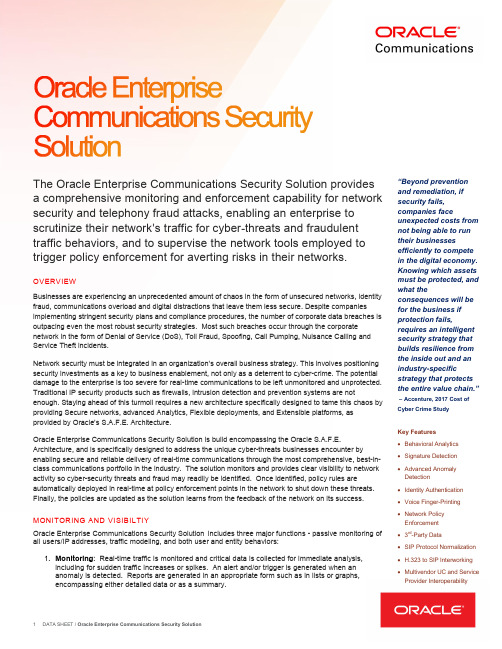
1 DATA SHEET / Oracle Enterprise Communications Security SolutionThe Oracle Enterprise Communications Security Solution provides a comprehensive monitoring and enforcement capability for network security and telephony fraud attacks, enabling an enterprise to scrutinize their network’s traffic for cyber-threats and fraudulent traffic behaviors, and to supervise the network tools employed to trigger policy enforcement for averting risks in their networks.OVERVIEWBusinesses are experiencing an unprecedented amount of chaos in the form of unsecured networks, identity fraud, communications overload and digital distractions that leave them less secure. Despite companies implementing stringent security plans and compliance procedures, the number of corporate data breaches is outpacing even the most robust security strategies. Most such breaches occur through the corporate network in the form of Denial of Service (DoS), Toll Fraud, Spoofing, Call Pumping, Nuisance Calling and Service Theft incidents.Network security must be integrated in an organization’s overall business strategy. This involves positioning security investments as a key to business enablement, not only as a deterrent to cyber-crime. The potential damage to the enterprise is too severe for real-time communications to be left unmonitored and unprotected. Traditional IP security products such as firewalls, intrusion detection and prevention systems are notenough. Staying ahead of this turmoil requires a new architecture specifically designed to tame this chaos by providing Secure networks, advanced Analytics, Flexible deployments, and Extensible platforms, as provided by Oracle’s S.A.F.E. Architecture.Oracle Enterprise Communications Security Solution is build encompassing the Oracle S.A.F.E.Architecture, and is specifically designed to address the unique cyber-threats businesses encounter byenabling secure and reliable delivery of real-time communications through the most comprehensive, best-in-class communications portfolio in the industry. The solution monitors and provides clear visibility to network activity so cyber-security threats and fraud may readily be identified. Once identified, policy rules areautomatically deployed in real-time at policy enforcement points in the network to shut down these threats. Finally, the policies are updated as the solution learns from the feedback of the network on its success. MONITORING AND VISIBILTIYOracle Enterprise Communications Security Solution includes three major functions - passive monitoring of all users/IP addresses, traffic modeling, and both user and entity behaviors:1. Monitoring : Real-time traffic is monitored and critical data is collected for immediate analysis, including for sudden traffic increases or spikes. An alert and/or trigger is generated when an anomaly is detected. Reports are generated in an appropriate form such as in lists or graphs, encompassing either detailed data or as a summary.“Beyond prevention and remediation, if security fails, companies faceunexpected costs from not being able to run their businessesefficiently to compete in the digital economy. Knowing which assets must be protected, and what theconsequences will be for the business if protection fails,requires an intelligent security strategy that builds resilience from the inside out and an industry-specificstrategy that protects the entire value chain.”– Accenture, 2017 Cost of Cyber Crime StudyKey Features Behavioral Analytics Signature Detection Advanced Anomaly Detection Identity Authentication Voice Finger-Printing Network Policy Enforcement 3rd -Party DataSIP Protocol Normalization H.323 to SIP Interworking Multivendor UC and Service Provider Interoperability2 DATA SHEET / Oracle Enterprise Communications Security Solution2. Traffic Modeling : Traffic patterns are automatically learned and the relevant information is stored to build a model of the network.3. Behavior : Scoring is applied when threshold limits are violated based on flexible rules to identify user or entity behaviors. NETWORK INTELLIGENCE AND POLICYPolicy is the deliberate system of principles to guide decisions and achieve rational outcomes. It may be used to enable or build a business, or used to protect against cyber-threats and fraud. Network monitoring, traffic modeling, and behavior analysis may trigger or define policy to control network behavior. For Policy to be effective and to provide a high degree of Network Intelligence, the use of advanced analytical methodologies and models is required.Intelligent Scoring and Thresholds : Scores are applied when thresholds are violated based on flexible policy rules. If scores are calculated that exceed predetermined thresholds, alarms are generated warning of security and/or fraud risks. Any deviation from the pattern indicates that the network could be facing an attack. However, relying on just one metric can result in false alerts. Therefore, Policy rules to calculate values from multiple metrics are used to enable a more accurate assessment of the situation. Predefined rules are available for immediate use or policy rules may be customized based upon:Metrics : Measures the basic attributes of user behaviors, such as: minutes spoken, concurrent calls, calls per second, etc.Rules : Used to determine what call behavior is considered a cyber-risk and at what severity, according to a configurable rating system. A rule can make use of any number of metrics.Values : The result of the weightings attributed to each rule. Values are provided for real-time and customer defined time intervals.Thresholds : Surpassing a defined threshold generates an alarm. Thresholds can either be static values or be dependent on Key Performance Indicators. The most powerful thresholds are fully automated and rely upon behavioral pattern deviations.Score : The accumulation of the values and is used to determine whether or not a destination has surpassed a threshold.POLICY ENFORCEMENTThe usual process to predict threats and to proactively prevent, detect and respond to them is often a manual procedure. Threats are typically identified in hindsight. Policies are then created to combat their future occurrences, and only later can those policies be enforced to prevent subsequent threats exhibiting the same behavior. This process may take days, even weeks, before successful eradication of recurrences of the threat can be achieved. Industry examples such as Equifax and Target took several weeks toidentify and resolve, and cost these firms not only financially, but also tarnished their brands as well. The Oracle Enterprise Communication Security Solution stays ahead of such attacks through the following:Automation : The ability to rapidly identify a threat, and then create and implement a policy to extinguish that threat, can translate to the very life or death of a company. If automation isintroduced at as many points along the Predict-Prevent-Detect-Respond continuum as is possible, threats may be killed off before they surface. Today, this capability is being done by a relatively limited number of offering, such as those products used within the Oracle EnterpriseCommunications Security Solution, including the Oracle Enterprise Telephony Fraud Monitor, the Oracle Communications Enterprise Session Border Controller and the Oracle CommunicationsSessions Delivery Manager. Together with the addition of cloud-based 3rd-party data, this solution enables a call to be blacklisted, rate-limited, or redirected by automatically enforced behaviors based on the policy definitions.Real-time Prevention : The real-time data monitoring of user behavior enables both faster and superior identification and prevention of cyber-threat behavior. The entire process, from detecting to stopping attacks, is shortened to just a few moments—or immediately, as with blacklisting. In this latter case, the system keeps a dynamic list of destinations that are known sources of attacks, such as in any of the enterprise’s connected networks. If the corresponding blacklist feature is enabled, then attacks can be stopped immediately.Fraud DetectionsInternational Premium Rate Service Numbers(IPRS) Call PumpingDenial of Service(DoS) Real-time Monitoring and Alerts Behavior Analytics Scoring and Threshold Triggers“…the situation has changed, from ‘our people versus their robots’ to ‘our robots versus their robots’”- Larry Ellison3DATA SHEET / Oracle Enterprise Communications Security SolutionReal-time Alerts: When scoring is calculated beyond the defined thresholds, immediatealerting is generated in case of known cyber-threat scenarios. In addition to such knownscenarios, if a call patterns does not match the pattern of the corresponding user or user group,and a critical threshold has been reached, and alert or trigger is generated.SUMMARYThe Oracle Enterprise Communications Security Solution is a self-learning, dynamic, end-to-end solutionthat helps enterprises detect both security and telephony fraud-based cyber-threats, and then preventsthem before further damage is done. The software systems are easily deployed and can fully integrate withexisting infrastructure or with the Oracle Cloud. Sessions are monitored in-network; called and callingbehavioral patterns learned and real-time is analysis performed, with the aid of 3rd-party data. Usingpredefined or customized rules from multiple metrics, the Oracle Enterprise Communications SecuritySolution identifies deviations in user behavior and stops cyber-threats and fraud attacks efficiently andeffectively. For more information, go to: /industries/communicationsRelated ProductsThe following productssupport Oracle EnterpriseCommunications SecuritySolution:Oracle Enterprise SessionBorder ControllerOracle EnterpriseCommunications BrokerOracle EnterpriseOperations MonitorOracle CommunicationsTelephony Fraud MonitorOracle CommunicationsInteractive SessionRecorderOracle CommunicationsSession Delivery ManagerOracle Failsafe SD-WANCONNECT WITH USCall +1.800.ORACLE1 or visit .Outside North America, find your local office at /contact./oracle /oracle /oracleCopyright © 2019, Oracle and/or its affiliates. All rights reserved. This document is provided for information purposes only, and the contents hereof aresubject to change without notice. This document is not warranted to be error-free, nor subject to any other warranties or conditions, whether expressedorally or implied in law, including implied warranties and conditions of merchantability or fitness for a particular purpose. We specifically disclaim anyliability with respect to this document, and no contractual obligations are formed either directly or indirectly by this document. This document may not bereproduced or transmitted in any form or by any means, electronic or mechanical, for any purpose, without our prior written permission.Oracle and Java are registered trademarks of Oracle and/or its affiliates. Other names may be trademarks of their respective owners.Intel and Intel Xeon are trademarks or registered trademarks of Intel Corporation. All SPARC trademarks are used under license and are trademarks orregistered trademarks of SPARC International, Inc. AMD, Opteron, the AMD logo, and the AMD Opteron logo are trademarks or registered trademarks ofAdvanced Micro Devices. UNIX is a registered trademark of The Open Group. 0319。
Oracle通信集中收费控制器SMS电子邮件接口闪烁指南说明书
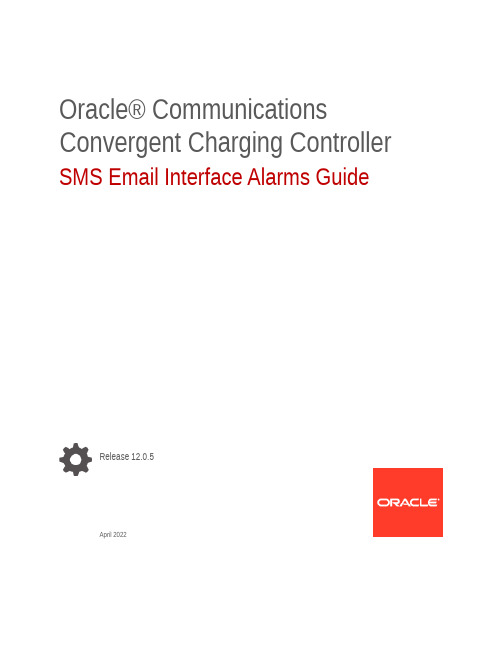
SMS Email Interface Alarms Guide
Release 12.0.5
April 2022
Copyright
Copyright © 2022, Oracle and/or its affiliates.
Severity Levels
This table describes the alarm severity levels.
Level Abbreviation Critical C Error E Warning W Notice N
Description
These alarms are raised when the application has encountered an error ifunction.
ii SMS Email Interface Alarms Guide
Contents
Alarm Topic Description ..............................................................................................................1 SMS Email Interface Alarms .......................................................................................................2
Oracle, Java, and MySQL are registered trademarks of Oracle and/or its affiliates. Other names may be trademarks of their respective owners.
Oracle Communications Services Gatekeeper 授权指南说明书
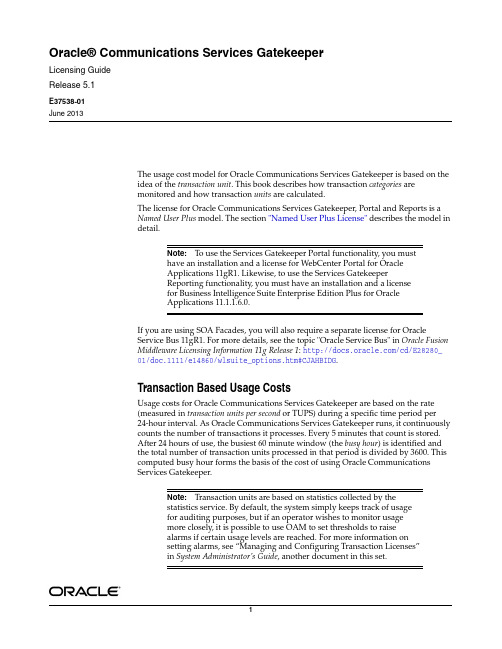
Oracle® Communications Services GatekeeperLicensing GuideRelease 5.1E37538-01June 2013The usage cost model for Oracle Communications Services Gatekeeper is based on theidea of the transaction unit. This book describes how transaction categories aremonitored and how transaction units are calculated.The license for Oracle Communications Services Gatekeeper, Portal and Reports is aNamed User Plus model. The section "Named User Plus License" describes the model indetail.Note: To use the Services Gatekeeper Portal functionality, you musthave an installation and a license for WebCenter Portal for OracleApplications 11gR1. Likewise, to use the Services GatekeeperReporting functionality, you must have an installation and a licensefor Business Intelligence Suite Enterprise Edition Plus for OracleApplications 11.1.1.6.0.If you are using SOA Facades, you will also require a separate license for OracleService Bus 11gR1. For more details, see the topic "Oracle Service Bus" in Oracle FusionMiddleware Licensing Information 11g Release 1: /cd/E28280_01/doc.1111/e14860/wlsuite_options.htm#CJAHBIDG.Transaction Based Usage CostsUsage costs for Oracle Communications Services Gatekeeper are based on the rate(measured in transaction units per second or TUPS) during a specific time period per24-hour interval. As Oracle Communications Services Gatekeeper runs, it continuouslycounts the number of transactions it processes. Every 5 minutes that count is stored.After 24 hours of use, the busiest 60 minute window (the busy hour) is identified andthe total number of transaction units processed in that period is divided by 3600. Thiscomputed busy hour forms the basis of the cost of using Oracle CommunicationsServices Gatekeeper.Note: Transaction units are based on statistics collected by thestatistics service. By default, the system simply keeps track of usagefor auditing purposes, but if an operator wishes to monitor usagemore closely, it is possible to use OAM to set thresholds to raisealarms if certain usage levels are reached. For more information onsetting alarms, see “Managing and Configuring Transaction Licenses”in System Administrator’s Guide, another document in this set.What specifically constitutes a transaction unit is based on the type of functionality being measured. Sending an SMS is not the same as setting up a call between twoparties. In general, the Oracle Communications Services Gatekeeper model is arranged in a tiered manner, using two large transaction categories, Base Platform and Oracle Module. Usage monitoring is based on the TUPS rates associated with these two transaction categories. For more information, see "Transactions - Categories and Units".Transactions - Categories and UnitsOracle Communications Services Gatekeeper keeps track of transaction units at two basic levels:■Base Platform TUPS , the larger and more general level, which tracks:-Platform Services , which covers services such as subscriber profile that can be used by multiple capabilities -Custom Modules , which covers custom communication services -And also includes, Oracle Module TUPS, which covers individualcommunication services.■Oracle Module TUPS , which tracks transaction units in Oracle Communications Services Gatekeeper supplied communication services, which fall into thefollowing groups:-Call Control -Messaging -Mobility -Presence -PaymentBase Platform TUPSThe larger and more general rate category is Base Platform TUPS. The Base Platform TUPS rate is the sum of the TUPS limits for Platform Services and Custom Modules plus that for Oracle Modules.Platform ServicesPlatform Services covers general services that can be used by multiple capabilities.These services include:■Subscriber Profile (based on Extended Web Services Subscriber Profile Interface)Note: In application-initiated scenarios, transaction units are loggedonly if Oracle Communications Services Gatekeeper returns an OK tothe application. If there is an exception, no transaction unit isrecorded. In network-triggered scenarios, transaction units are loggedonly if Oracle Communications Services Gatekeeper returns an OK tothe network. If there is an exception, no transaction unit is recorded.Application-initiated - Subscriber ProfileA Subscriber Profile transaction unit is recorded in the following situations:■Getting one or more attributes from a subscriber profile.■Getting either a whole or a subset of a profile identified by a profile ID. Network-triggeredNetwork-triggered scenarios are not applicable for subscriber profile.Custom ModulesCustom Modules covers communication services or custom modules created using Oracle Communications Services Gatekeeper’s Platform Development Toolkit.In general there are two main types of custom module transactions:■Application-initiated■Network-triggeredApplication-initiatedA transaction unit for a custom module application-initiated scenario:Oracle Communications Services Gatekeeper processes a request that is submitted by the application and passes it to the underlying network node and then Oracle Communications Services Gatekeeper processes the response that is submitted by the underlying network node and passes it to the application.Note: The exact sequence of request and response is defined duringthe custom module development process.Figure 1 illustrates when a generic custom module application-initiated transaction unit is logged. The illustrated operations are generic and abstract and would depend on which application-facing interface and/or network protocol the communication service is using.Figure 1 TU definition Custom Module application-initiated ScenarioNetwork-triggeredA transaction unit for a custom module network-triggered scenario:Oracle Communications Services Gatekeeper processes a request that is submitted by the telecom network node and passes it on to the application, which processes it and returns a response to Oracle Communications Services Gatekeeper, which passes it on to the telecom network node.Figure 2 illustrates when a generic custom module network-triggered transaction unit is logged. The illustrated operations are generic and abstract and would depend on which application-facing interface and/or network protocol the communication service is using.Figure 2 TU definition Custom Module network-triggered scenarioOracle Module TUPSThe second rate category is Oracle Module TUPS. The Oracle Module TUPS rate measures the total transaction rate for communication services delivered as a part of Oracle Communications Services Gatekeeper.For definitional purposes, Oracle Module-based communication services are divided into the following transaction groups:■Messaging ■Mobility ■Call Control ■Presence ■PaymentMessagingThe Messaging transaction group covers transactions for the following Parlay X 2.1 and RESTful communication services:■Short Messaging ■Multimedia MessagingIt also covers transactions for all Extended Web Services and RESTful WAP Push communication services, the Binary SMS communication service, the native MM7 communication service and the native UCP service.There are two main types of transaction units in the Messaging group:■Application-initiated ■Network-triggeredApplication-initiatedIn an application-initiated scenario, a transaction unit consists of the following sequence:Oracle Communications Services Gatekeeper receives a request from an application and passes it on to the underlying network node. If notifications have been set up, Oracle Communications Services Gatekeeper also receives the delivery notification from the network and passes it back to the application. Even if the message isdistributed to a group of destination addresses, only one transaction unit is logged per message.Network-triggeredIn a network-triggered scenario, a transaction unit consists of one of the following two sequences:■Oracle Communications Services Gatekeeper receives a message from the network node and passes it on to the application.Note: If the application is not registered for delivery notifications,the transaction unit is not affected.■Oracle Communications Services Gatekeeper receives a message from the network node and consumes the message itself. In this case, Oracle CommunicationsServices Gatekeeper itself acts as the application.MobilityThe Mobility transaction group covers transactions for the following Parlay X 2.1 and RESTful communication services:■Terminal LocationThere are two main types of transaction units in the Mobility group:■Application-initiated■Network-triggered Application-initiatedIn an application-initiated scenario, a transaction unit consists of one of the twofollowing sequences:■Oracle Communications Services Gatekeeper receives a polling request for location from an application and passes it to the underlying network node. OracleCommunications Services Gatekeeper then receives the immediate response thatthe underlying network node returns and passes it back to the application. Group requests are treated the same as single requests.■Network receives a notification setup request from an application that also requests an immediate location check.A transaction unit is not recorded in the following situation:■Oracle Communications Services Gatekeeper receives a notification setup request that does not include an immediate status or location checkNetwork-triggeredIn a network-triggered scenario, a transaction unit consists of the following sequence:Oracle Communications Services Gatekeeper receives a notification request that is submitted by the network node and then passes it on to the application.Call ControlThe Call Control transaction group includes transactions for the following Parlay X2.1/3.0 and RESTful communication services:■Third Party Call ■Call NotificationNote: An immediate check followed by a status notification is considered two transaction units.Note: For the purposes of logging transaction units, all notificationtriggers are equivalent: periodic, geographical, or state-change basedare logged in the same manner.■Audio CallThere are two main types of transaction units in the Call Control group:■Application-initiated■Network-triggeredApplication-initiatedIn an application-initiated scenario, a transaction unit consists of one of the following:■An application requests that Oracle Communications Services Gatekeeper setup a third party call. For the purposes of logging transaction units, no distinction is made based on who eventually terminates the call: the application, the caller or the callee.■An application requests that Oracle Communications Services Gatekeeper add or transfer a participant in a call (PX 3.0 only).■An application requests that Oracle Communications Services Gatekeeper either play an Audio Call message of any type or play a message and collect digits (PX3.0 only).Network-triggeredIn a network-triggered scenario, a transaction unit consists of one of the two following sequences:■Oracle Communications Services Gatekeeper receives a notification request from the network node and passes it on to the application. The request contains status information about the call, such as the callee is busy or not answering. Nodistinction is made between a notification that arrives in notify mode (forinformation only) and one that arrives in interrupt mode (where the call can be manipulated in the return message from the application).■Oracle Communications Services Gatekeeper receives a notification request from the network node and processes the call itself, based on rules that have beenprovisioned by the application at an earlier time.PresenceThe Presence transaction group covers transactions for the following Parlay X 2.1 and RESTful communication services:■PresenceThere are three main types of transaction units in the Presence group:■Application-initiated - Watcher■Network-triggered - Watcher■Application-initiated - PresentityApplication-initiated - WatcherIn an application-initiated scenario, a transaction unit consists of the following: Oracle Communications Services Gatekeeper receives a polling request for user presence information from an application and passes it to the underlying network node. Oracle Communications Services Gatekeeper then receives the immediateresponse that the underlying network node returns and passes it back to the application.Network-triggered - WatcherIn a network-triggered scenario, a transaction unit consists of the following:Oracle Communications Services Gatekeeper receives a status change notification request from the network node and passes it on to the application.Application-initiated - PresentityIn an application-initiated scenario, a transaction unit consists of the following:A presentity publishes its presence information to Oracle Communications Services Gatekeeper, which passes it on to the Presence Server.PaymentThe Payment transaction group covers transactions for the following Parlay X 3. 0 and RESTful communication services:■PaymentThe Payment transaction group includes only application-initiated requests. Application-initiatedA Payment transaction unit is recorded in the following situations■Charging or refunding an amount■Charging a split amount■Reserving an initial amount and releasing it■Reserving an initial amount and charging it■Reserving an additional amountA payment transaction unit is not recorded in the following situation:■Releasing a previously held amountNamed User Plus LicenseNamed User Plus is the licensing model used for both Services Gatekeeper Portals and Reporting. This section describes the terms of that license model.Named User Plus is defined as an individual authorized by you to use the programs which are installed on a single server or multiple servers, regardless of whether the individual is actively using the programs at any given time. A non-human operated device will be counted as a named user plus in addition to all individuals authorized to use the programs, if such devices can access the programs. If multiplexing hardware or software (for example, a TP monitor or a web server product) is used, this number must be measured at the multiplexing front end. Automated batching of data from computer to computer is permitted. You are responsible for ensuring that the named user plus per processor minimums are maintained for the programs contained in the user minimum table in the licensing rules section; the minimums table provides for the minimum number of named users plus required and all actual users must be licensed.Documentation AccessibilityFor information about Oracle's commitment to accessibility, visit the Oracle Accessibility Program website at/pls/topic/lookup?ctx=acc&id=docacc.Access to Oracle SupportOracle customers have access to electronic support through My Oracle Support. For information, visit /pls/topic/lookup?ctx=acc&id=info or visit /pls/topic/lookup?ctx=acc&id=trs if you are hearing impaired.Copyright © 2013, Oracle and/or its affiliates. All rights reserved.This software and related documentation are provided under a license agreement containing restrictions on use and disclosure and are protected by intellectual property laws. Except as expressly permitted in your license agreement or allowed by law, you may not use, copy, reproduce, translate, broadcast, modify, license, transmit, distribute, exhibit, perform, publish, or display any part, in any form, or by any means. Reverse engineering, disassembly, or decompilation of this software, unless required by law for interoperability, is prohibited.The information contained herein is subject to change without notice and is not warranted to be error-free. If you find any errors, please report them to us in writing.If this is software or related documentation that is delivered to the U.S. Government or anyone licensing it on behalf of the U.S. Government, the following notice is applicable:U.S. GOVERNMENT END USERS: Oracle programs, including any operating system, integrated software, any programs installed on the hardware, and/or documentation, delivered to U.S. Government end users are "commercial computer software" pursuant to the applicable Federal Acquisition Regulation and agency-specific supplemental regulations. As such, use, duplication, disclosure, modification, and adaptation of the programs, including any operating system, integrated software, any programs installed on the hardware, and/or documentation, shall be subject to license terms and license restrictions applicable to the programs. No other rights are granted to the U.S. Government.This software or hardware is developed for general use in a variety of information management applications. It is not developed or intended for use in any inherently dangerous applications, including applications that may create a risk of personal injury. If you use this software or hardware in dangerous applications, then you shall be responsible to take all appropriate fail-safe, backup, redundancy, and other measures to ensure its safe use. Oracle Corporation and its affiliates disclaim any liability for any damages caused by use of this software or hardware in dangerous applications. Oracle and Java are registered trademarks of Oracle and/or its affiliates. Other names may be trademarks of their respective owners.Intel and Intel Xeon are trademarks or registered trademarks of Intel Corporation. All SPARC trademarks are used under license and are trademarks or registered trademarks of SPARC International, Inc. AMD, Opteron, the AMD logo, and the AMD Opteron logo are trademarks or registered trademarks of Advanced Micro Devices. UNIX is a registered trademark of The Open Group.This software or hardware and documentation may provide access to or information on content, products, and services from third parties. Oracle Corporation and its affiliates are not responsible for and expressly disclaim all warranties of any kind with respect to third-party content, products, and services. Oracle Corporation and its affiliates will not be responsible for any loss, costs, or damages incurred due to your access to or use of third-party content, products, or services.。
- 1、下载文档前请自行甄别文档内容的完整性,平台不提供额外的编辑、内容补充、找答案等附加服务。
- 2、"仅部分预览"的文档,不可在线预览部分如存在完整性等问题,可反馈申请退款(可完整预览的文档不适用该条件!)。
- 3、如文档侵犯您的权益,请联系客服反馈,我们会尽快为您处理(人工客服工作时间:9:00-18:30)。
Oracle® Communications Data ModelRelease Notes11g Release 2 (11.2)E15888-05September 2010This document contains important information that was not included in thedocumentation for Release 11.2.3 of Oracle Communications Data Model.This document may be updated after it is released. To check for updates to thisdocument and to view other Oracle documentation, refer to the Documentationsection on the Oracle Technology Network (OTN) Web site:/technology/documentation/index.htmlThis document contains the following topics:■Section1, "Conformance Certified with TM Forum’s SID"■Section2, "OLAP Model Issues"■Section3, "Inter-ETL Issues"■Section4, "Deinstallation Issue"■Section5, "Bugs Fixed"■Section6, "Related Documentation"■Section7, "Documentation Accessibility"1Conformance Certified with TM Forum’s SIDOracle Communications Data Model Release 11.2.3 has been “Conformance Certified”with the TeleManagement Forum’s Information Framework (SID) version 8.1. Formore information see the SID conformance section in Oracle Communications DataModel Reference.2OLAP Model IssuesIn the base tables, Charge Quantity and Charge Amount are measures specific toInvoice Item Type. However, in the Oracle Communications Data Model analyticworkspace, the Invoice Item Type is not one of the dimensions of the Invoice CustomerType (ICT) cube, and the values for Charge Quantity and Charge Amount in the ICTcube are consolidated values rather than values associated with a specific item type.For more information, see bug 9291530.Workaround: There are two possible workarounds for this issue:■Remove the CHRG_AMT and CHRG_QTY fields from the DWA_INVC_CUST_TYP table in the ocdm_sys schema and remove the CA and CQ measures from the ICTcube in the Oracle Communications Data Model analytic workspace.■Rename the CHRG_AMT and CHRG_QTY fields in the DWA_INVC_CUST_TYP table in the ocdm_sys schema and the CA and CQ measures in the ICT cube to reflectthat these measures represent consolidated amounts rather than amounts forsingle-invoice items.3Inter-ETL IssuesWhen executing the DWD_SL_RPRSTV_STTSTC__MAP , where customers mayencounter an Oracle internal error of ORA-12805 is fixed (bug 9164319).Workaround : Apply the appropriate Oracle Database 11.2.0.1 patch.For more information, see bug 9217342.4Deinstallation IssueWhen deinstallation is performed in an Oracle Real Application Clusters (Oracle RAC) environment, the Oracle Communications Data Model component entries are not removed from the respective inventories of the remote node(s).In an Oracle RAC environment the deinstallation may report the following warning message.Deinstall successfulWARNING: Error while copying directory/path/product/11.2.0/dbhome_1/inventory with exclude file listThis issue does not affect reinstallation, as Oracle Communications Data Model can be reinstalled with the existing inventory entries. However, the deinstallation is notcomplete in an Oracle RAC environment without the removal of the componententries from the Oracle Inventory on the remote nodes of a cluster.For more information, see bug 10118968.Workaround: You may manually remove the Oracle Communications Data Model component entries from the Oracle Inventory on the remote nodes of a cluster.5Bugs FixedThis release of Oracle Communications Data Model fixes bugs in the following areas:■Documentation Bug Fixes ■Inter-ETL Bug Fixes ■Logical and Physical Model Bug Fixes5.1Documentation Bug FixesThis release of Oracle Communications Data Model fixes the following bugs inChapter 2, "Logical Data Foundation" of Oracle Communications Data Model Reference :See also:Discussion on error recovery in Oracle CommunicationsData Model Installation Guide .■The diagram of the PARTY entity (bug 10008118).■The description of the EQUIPMENT entity (bug 9752005).■The description of the ACCOUNT STATUS HISTORY entity (bug 9979342)5.2Inter-ETL Bug FixesThis release of Oracle Communications Data Model fixes bugs in the following areas of the inter-ETL:■Improved performance when reloading CDR tables with existing loaded data■Intra-ETL Mappings rewritten to improve performance■Unnecessary Intra-ETL mapping removed5.2.1Improved performance when reloading CDR tables with existing loaded data Previous loaded data is now removed using TRUNCATE over partitions rather than DELETE (bug 9803374).5.2.2Intra-ETL Mappings rewritten to improve performanceThe following mappings were rewritten to improve performance:■DWD_ARPU_BASE_MAP (bug 9750104)■DWD_DATA_USG_DAY_MAP (bug 985422)■DWD_INVC_ADJ_MAP (bug 9854206)■DWD_PYMT_AGNG_DAY_MAP (bug 9702339)■DWD_SBCRBR_CHRN_STTSTC_MAP (bug 9775493)■DWD_VAS_USG_DAY_MAP (bugs 9854221 and 9877089)■DWD_VOI_CALL_DAY_MAP (bug 9854221)5.2.3Unnecessary Intra-ETL mapping removedDWD_CUST_ACQSTN_SUMM_DAY_MAP is removed as it is unnecessary (bug 9970542).5.3Logical and Physical Model Bug FixesBeside the extensions needed to support SID (see "Conformance Certified with TM Forum’s SID" on page1and bug 9696519), this release of Oracle Communications Data Model extends the logical and physical models in the following ways:■The logical and physical models are extended so that you can query as to which customer has spent how much time on a web site (bug 10012007). See OracleCommunications Data Model Reference for more information.■Support added to Lookup tables for star schema dimension value of null. (bug 9922943)6Related DocumentationThis release of Oracle Communications Data Model includes the following documentation:■Oracle Communications Data Model Installation Guide that describes how to install and configure the Oracle Communications Data Model.■Oracle Communications Data Model Reference that describes the data model structures for Oracle Communications Data Model.■Oracle Communications Data Model Operations Guide that describes the tasks and procedures that must be performed after Oracle Communications Data Model is installed, and periodically afterwards to maintain useful performance. Since the needs of each Oracle Communications Data Model environment are unique,Oracle Communications Data Model is configurable so it can be modified toaddress each customer's needs.7Documentation AccessibilityOur goal is to make Oracle products, services, and supporting documentation accessible to all users, including users that are disabled. To that end, our documentation includes features that make information available to users of assistive technology. This documentation is available in HTML format, and contains markup to facilitate access by the disabled community. Accessibility standards will continue to evolve over time, and Oracle is actively engaged with other market-leading technology vendors to address technical obstacles so that our documentation can be accessible to all of our customers. For more information, visit the Oracle Accessibility Program Web site at /accessibility/.Accessibility of Code Examples in DocumentationScreen readers may not always correctly read the code examples in this document. The conventions for writing code require that closing braces should appear on an otherwise empty line; however, some screen readers may not always read a line of text that consists solely of a bracket or brace.Accessibility of Links to External Web Sites in DocumentationThis documentation may contain links to Web sites of other companies or organizations that Oracle does not own or control. Oracle neither evaluates nor makes any representations regarding the accessibility of these Web sites.Access to Oracle SupportOracle customers have access to electronic support through My Oracle Support. For information, visit /support/contact.html or visit /accessibility/support.html if you are hearing impaired.Oracle Communications Data Model Installation Guide, 11g Release 2 (11.2)E15888-05Copyright © 2010, Oracle and/or its affiliates. All rights reserved.This software and related documentation are provided under a license agreement containing restrictions on use and disclosure and are protected by intellectual property laws. Except as expressly permitted in your license agreement or allowed by law, you may not use, copy, reproduce, translate, broadcast, modify, license, transmit, distribute, exhibit, perform, publish, or display any part, in any form, or by any means. Reverse engineering, disassembly, or decompilation of this software, unless required by law for interoperability, is prohibited.The information contained herein is subject to change without notice and is not warranted to be error-free. If you find any errors, please report them to us in writing.If this software or related documentation is delivered to the U.S. Government or anyone licensing it on behalf of the U.S. Government, the following notice is applicable:U.S. GOVERNMENT RIGHTS Programs, software, databases, and related documentation and technical data delivered to U.S. Government customers are "commercial computer software" or "commercial technical data" pursuant to the applicable Federal Acquisition Regulation and agency-specific supplemental regulations. As such, the use, duplication, disclosure, modification, and adaptation shall be subject to the restrictions and license terms set forth in the applicable Government contract, and, to the extent applicable by the terms of the Government contract, the additional rights set forth in FAR 52.227-19, Commercial Computer Software License (December 2007). Oracle USA, Inc., 500 Oracle Parkway,Redwood City, CA 94065.This software is developed for general use in a variety of information management applications. It is not developed or intended for use in any inherently dangerous applications, including applications which may create a risk of personal injury. If you use this software in dangerous applications, then you shall be responsible to take all appropriate fail-safe, backup, redundancy, and other measures to ensure the safe use of this software. Oracle Corporation and its affiliates disclaim any liability for any damages caused by use of this software in dangerous applications.Oracle is a registered trademark of Oracle Corporation and/or its affiliates. Other names may be trademarks of their respective owners.This software and documentation may provide access to or information on content, products, and services from third parties. Oracle Corporation and its affiliates are not responsible for and expressly disclaim all warranties of any kind with respect to third-party content, products, and services. Oracle Corporation and its affiliates will not be responsible for any loss, costs, or damages incurred due to your access to or use of third-party content, products, or services.。
